SAT Test Prep
CHAPTER 2
DIAGNOSTIC SAT

ANSWER SHEET

Directions for Test
• Remove these answer sheets from the book and use them to record your answers to this test.
• This test will require 3 hours and 20 minutes to complete. Take this test in one sitting.
• The time allotment for each section is written clearly at the beginning of each section. This test contains six 25-minute sections, two 20-minute sections, and one 10-minute section.
• This test is 25 minutes shorter than the actual SAT, which will include a 25-minute “experimental” section that does not count toward your score. That section has been omitted from this test.
• You may take one short break during the test, of no more than 10 minutes in length.
• You may only work on one section at any given time.
• You must stop ALL work on a section when time is called.
• If you finish a section before the time has elapsed, check your work on that section. You may NOT work on any other section.
• Do not waste time on questions that seem too difficult for you.
• Use the test book for scratchwork, but you will receive credit only for answers that are marked on the answer sheets.
• You will receive one point for every correct answer.
• You will receive no points for an omitted question.
• For each wrong answer on any multiple-choice question, your score will be reduced by ¼ point.
• For each wrong answer on any “numerical grid-in” question, you will receive no deduction.
When you take the real SAT, you will be asked to fill in your personal information in grids as shown below.

Start with number 1 for each new section. If a section has fewer questions than answer spaces, leave the extra answer spaces blank. Be sure to erase any errors or stray marks completely.


CAUTION
Use the answer spaces in the grids below for Section 2 or Section 3 only if you are told to do so in your test book.
Student-Produced Responses

Start with number 1 for each new section. If a section has fewer questions than answer spaces, leave the extra answer spaces blank. Be sure to erase any errors or stray marks completely.


CAUTION
Use the answer spaces in the grids below for Section 4 or Section 5 only if you are told to do so in your test book.
Student-Produced Responses

Start with number 1 for each new section. If a section has fewer questions than answer spaces, leave the extra answer spaces blank. Be sure to erase any errors or stray marks completely.


CAUTION
Use the answer spaces in the grids below for Section 6 or Section 7 only if you are told to do so in your test book.
Student-Produced Responses

Start with number 1 for each new section. If a section has fewer questions than answer spaces, leave the extra answer spaces blank. Be sure to erase any errors or stray marks completely.


ESSAY
Time—25 minutes
Write your essay on separate sheets of standard lined paper.
The essay gives you an opportunity to show how effectively you can develop and express ideas. You should, therefore, take care to develop your point of view, present your ideas logically and clearly, and use language precisely.
Your essay must be written on the lines provided on your answer sheet—you will receive no other paper on which to write. You will have enough space if you write on every line, avoid wide margins, and keep your handwriting to a reasonable size. Remember that people who are not familiar with your handwriting will read what you write. Try to write or print so that what you are writing is legible to those readers.
Important reminders:
• A pencil is required for the essay. An essay written in ink will receive a score of zero.
• Do not write your essay in your test book. You will receive credit only for what you write on your answer sheet.
• An off-topic essay will receive a score of zero.
You have 25 minutes to write an essay on the topic assigned below.
Consider carefully the issue discussed in the following passage, then write an essay that answers the question posed in the assignment.
In a culture obsessed with superficial appearances, our leaders should be those who can see beyond the surface. Judging a book by its cover is the job of the consumer, but reading the book—pondering its contents and perhaps seeking to write new chapters—is the job of a leader.
Assignment: How important is it to look beyond superficial appearances? Write an essay in which you answer this question and discuss your point of view on this issue. Support your position logically with examples from literature, the arts, history, politics, science and technology, current events, or your experience or observation.
If you finish before time is called, you may check your work on this section only. Do not turn to any other section in the test.
SECTION 2
Time—25 minutes
20 questions
Turn to Section 2 of your answer sheet to answer the questions in this section.
Directions: For this section, solve each problem and decide which is the best of the choices given. Fill in the corresponding circle on the answer sheet. You may use any available space for scratchwork.
Notes
1. The use of a calculator is permitted.
2. All numbers used are real numbers.
3. Figures that accompany problems in this test are intended to provide information useful in solving the problems. They are drawn as accurately as possible EXCEPT when it is stated in a specific problem that the figure is not drawn to scale. All figures lie in a plane unless otherwise indicated.
4. Unless otherwise specified, the domain of any function f is assumed to be the set of all real numbers x for which f (x) is a real number.
Reference Information

The number of degrees of arc in a circle is 360.
The sum of the measures in degrees of the angles of a triangle is 180.
1. If ![]() and
and ![]() , what is the value of m?
, what is the value of m?
(A) 0
![]()
(C) 1
(D) 2
(E) 4
2. The average (arithmetic mean) of three numbers is 50. If two of the numbers are 35 and 50, what is the third number?
(A) 45
(B) 50
(C) 55
(D) 60
(E) 65

3. In the correctly worked addition problem above, each A represents the same digit. What is the value of A?
(A) 1
(B) 2
(C) 3
(D) 4
(E) 6
4. What number is the same percent of 225 as 9 is of 25?
(A) 27
(B) 45
(C) 54
(D) 64
(E) 81
5. If ![]() , what is the value of x?
, what is the value of x?
(A) 4
(B) 6
(C) 9
(D) 16
(E) 17
VOTING RESULTS FOR REFERENDUM

6. The table above, representing the results of a vote taken by the Zoning Commission on a recent referendum, is only partially completed. Based on the table, how many women on the Commission voted no?
(A) 43
(B) 48
(C) 57
(D) 61
(E) 78
7. Kenny and Mike each begin with the same number of baseball cards. After Mike gives Kenny 12 cards, Kenny has twice as many as Mike. How many cards do they have all together?
(A) 36
(B) 48
(C) 60
(D) 72
(E) 84
8. A bag of Texas Tillie”s Trail Mix contains x ounces of walnuts, 15 ounces of peanuts, and 20 ounces of pecans. Which of the following expressions gives the fraction of the mix that is walnuts?
![]()
![]()
![]()
![]()
![]()
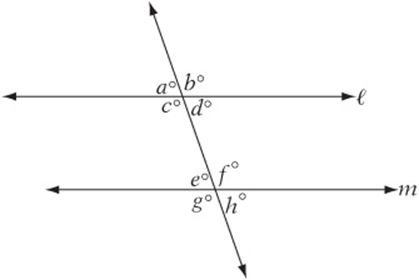
9. In the diagram above, if ℓ || m, which of the following is equivalent to ![]() ?
?
![]()
![]()
![]()
![]()
![]()
10. For which of the following ordered pairs (x, y) is ![]() and
and ![]() ?
?
(A) (7, –1)
(B) (7, 1)
(C) (4, –3)
(D) (3, 3)
(E) (–3, 4)
11. When n is divided by 12, the remainder is 6. What is the remainder when n is divided by 6?
(A) 0
(B) 1
(C) 2
(D) 3
(E) 4
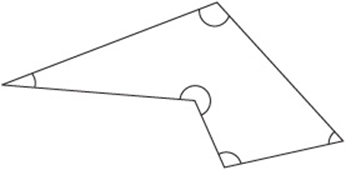
12. The figure above shows a polygon with five sides. What is the average (arithmetic mean) of the measures, in degrees, of the five angles shown?
(A) 85°
(B) 108°
(C) 120°
(D) 324°
(E) 540°
13. At a pet store, if d represents the number of dogs and c represents the number of cats, then which of the following is equivalent to the statement “The number of dogs is 3 fewer than 4 times the number of cats?”
![]()
![]()
![]()
![]()
![]()
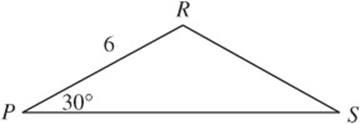
14. In the figure above, if ![]() , what is the area of triangle PRS?
, what is the area of triangle PRS?
![]()
![]()
![]()
![]()
![]()
15. A $50,000 prize is divided among four winners in a ratio of 4:3:2:1. What is the greatest amount of money that any winner receives?
(A) $5,000
(B) $10,000
(C) $12,500
(D) $20,000
(E) $40,000
16. For all non-zero integers a and b, let  .
.
If ![]() , which of the following must be true?
, which of the following must be true?
![]()
![]()
![]() is an integer.
is an integer.
(A) II only
(B) I and II only
(C) II and III only
(D) I and III only
(E) I, II, and III
17. A jar contains only red, white, and blue marbles. It contains twice as many red marbles as white marbles and three times as many white marbles as blue marbles. If a marble is drawn at random, what is the probability that it is white?
![]()
![]()
![]()
![]()
![]()
18. A certain class has 6 girls and 5 boys. Four of these students are to line up in the front of the room, with two girls on either end and two boys in between. How many such arrangements are possible?
(A) 20
(B) 200
(C) 462
(D) 600
(E) 900
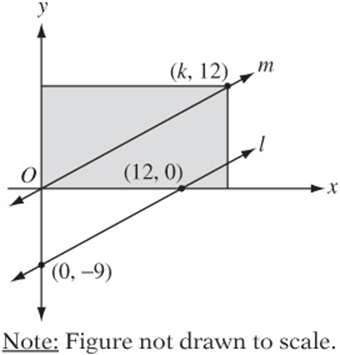
19. In the figure above, if m || l, what is the area of the shaded rectangle?
(A) 96
(B) 108
(C) 144
(D) 192
(E) 204
20. A rectangular solid is a centimeters long, b centimeters wide, and c centimeters high. Its volume is v cubic centimeters and its surface area is s square centimeters. If a, b, c, v, and s are all integers, and v is odd, which of the following must be true?
![]() is odd.
is odd.
![]()
III. s is even.
(A) I only
(B) I and II only
(C) I and III only
(D) I and III only
(E) I, II, and III

If you finish before time is called, you may check your work on this section only. Do not turn to any other section of the test.
SECTION 3
Time—25 minutes
24 questions
Turn to Section 3 of your answer sheet to answer the questions in this section.
Directions: For each question in this section, select the best answer from among the choices given and fill in the corresponding circle on the answer sheet.
Each sentence below has one or two blanks, each blank indicating that something has been omitted. Beneath the sentence are five words or sets of words labeled A through E. Choose the word or set of words that, when inserted in the sentence, best fits the meaning of the sentence as a whole.
EXAMPLE:
Rather than accepting the theory unquestioningly, Deborah regarded it with-----.
(A) mirth
(B) sadness
(C) responsibility
(D) ignorance
(E) skepticism
![]()
1. They enjoyed each other”s company enormously, but they rarely agreed on any issue; in fact, one could be sure that on any important topic their opinions would -------.
(A) diverge
(B) coincide
(C) retreat
(D) assemble
(E) truncate
2. Once accepted as an incontrovertible truth, the theory that nine planets revolve around our sun is now regarded by astronomers as ------.
(A) enacted
(B) irrefutable
(C) universal
(D) dubious
(E) conclusive
3. Having lost his wife and three children to untimely deaths, Rembrandt entered his dark period in 1642, when his immersion in painting often seemed his only ------- from abject -------.
(A) salvation . . prudence
(B) remorse . . adulation
(C) solace . . melancholy
(D) elation . . poverty
(E) departure . . cheerfulness
4. Many proponents of the new curriculum considered its omission of Romance literature to be -------, while the more conservative educators considered such a removal -------.
(A) repugnant . . premature
(B) innocuous . . deplorable
(C) reprehensible . . benevolent
(D) malicious . . disgraceful
(E) auspicious . . encouraging
5. As the expedition leader quickly realized, the recently accelerated program to acclimate the climbers to high altitudes was -------; as a result, several team members were soon ------- by the lack of oxygen.
(A) illusory . . initiated
(B) excessive . . mitigated
(C) appropriate . . confused
(D) ineffective . . enervated
(E) venerable . . absolved
6. Although the mainstream of most societies reviles the -------, nearly every culture reserves at least some small place for those who question its treasured norms and mores.
(A) charlatan
(B) surrogate
(C) philanthropist
(D) pragmatist
(E) iconoclast
7. Steven Pinker is far from ------- about the heated controversy of whether the human mind is a tabula rasa; he stands ------- in the negative camp.
(A) ambivalent . . unequivocally
(B) apathetic . . furtively
(C) impartial . . reluctantly
(D) adamant . . vehemently
(E) subjective . . stubbornly
8. Although Ivan Illich was dismissed as a ------- by many of his contemporaries, many modern thinkers now regard his revolutionary insight into the dehumanization of society as -------.
(A) pedant . . derivative
(B) neophyte . . vociferous
(C) radical . . visionary
(D) partisan . . conciliatory
(E) hermit . . simplistic
The passages below are followed by questions based on their content. Answer the questions on the basis of what is stated or implied in the passage and in any introductory material that may be provided.
Questions 9–12 are based on the following passages.


9. Both passages focus primarily on
(A) how groups of cells form tissues
(B) the origin of life on Earth
(C) biochemical processes
(D) the importance of the sun to life on Earth
(E) unusual life forms
10. The questions listed in lines 4–11 of Passage 1 are presented as those that
(A) biologists have yet to explore in great depth
(B) inspire controversy within the scientific community
(C) necessarily concern those who are interested in a deep understanding of biology
(D) are difficult to investigate with current methods and technology
(E) researchers have considered to be less important than ecological questions
11. Which of the five questions posed in Passage 1 is most relevant to the discussion in Passage 2?
(A) How does photosynthesis convert the energy of sunlight into the energy of sugar molecules?
(B) What is the structure of the cell membrane, and how does it function in controlling the movement of materials into and out of the cell?
(C) How do muscles contract?
(D) How do the nerve cells in your brain communicate with one another?
(E) What causes cancer?
12. Which of the following concepts is mentioned in Passage 2 but NOT in Passage 1?
(A) the structure of cells
(B) the conversion of light energy to food energy
(C) disease
(D) relationships among separate organisms
(E) bonds within molecules
Passage 1: Audesirk/Audesirk/Byers, Biology: Life on Earth, 2nd ed. Copyright © 2006 by Pearson Education, Inc.
Questions 13–18 are based on the following passage.
The following is an excerpt from a popular book on “innumeracy,” the common inability of people to deal rationally with numbers.



13. Which of the following can be inferred to be the author”s view of the “reports that more than a million American kids are kidnapped each year” (lines 4–5)?
(A) They are typical examples of American journalism.
(B) They are evidence of a terrible problem that must be addressed.
(C) They are probably untrue.
(D) They properly use a number to convey a simple fact.
(E) They demonstrate an American obsession with statistics.
14. What fact is the list of probabilities cited in lines 21–26 intended to illustrate?
(A) that probability can be used in many different ways in everyday life
(B) that terrorism is far less a threat to Americans than many other common dangers
(C) that the world is filled with many dangers
(D) that a knowledge of probability can help Americans decide where to travel most safely abroad
(E) that bicycles are nearly as dangerous as cars
15. Which of the following is not an element of the discussion in this passage?
(A) a personal recollection
(B) a verifiable statistic
(C) a reference to an authoritative study
(D) a discussion of a common misconception
(E) a refutation of a scientific theory
16. What is the author”s view of the “penetrating insight” mentioned in line 33?
(A) It is the result of careful analysis.
(B) It is illogical.
(C) It demolishes a statistical argument.
(D) It does not sufficiently personalize the situation being discussed.
(E) It is not found enough in everyday discussions.
17. In what way does the author suggest that the joke described in lines 41–46 is like “slipping between millions and billions” (lines 49–50)?
(A) They both involve a lack of appreciation for particular quantities.
(B) They both describe mistakes the elderly are likely to make.
(C) They both illustrate a common scenario.
(D) They both reveal the value of understanding probabilities.
(E) They both illustrate humor in mathematics.
18. The author mentions the time span of “approximately 20 minutes” (lines 61–62) in order to emphasize
(A) the doctor”s inability to appreciate relevant time spans
(B) the comparison with the elderly couple in the preceding joke
(C) the frequency with which the doctor contradicted himself
(D) the common need to approximate rather than use precise numbers
(E) how quickly he was able to get an appointment
Excerpted from “Examples and Principles” from Innumeracy by John Allen Paulos. Copyright © 1988 by John Allen Paulos.
Reprinted by permission of Hill and Wang, a division of Farrar, Straus and Giroux, LLC.
Questions 19–24 are based on the following passage.
The following is an excerpt from a memoir of Richard Feynman, a Nobel Prize–winning physicist, in which he describes the experience of having an artist friend named Jerry teach him to draw.


19. In line 13, the word “organization” most nearly means
(A) corporation
(B) rules of physics
(C) social group
(D) arrangement of objects
(E) system of emotional expression
20. Which of the following experiences is closest to what the author describes as “dramatic and wonderful” (lines 18–19)?
(A) proving a physical law
(B) creating a beautiful sculpture
(C) appreciating the power of physical laws in nature
(D) teaching another person how to play an instrument
(E) seeing a masterful painting for the first time
21. What assumption does the author make about the appreciation of art?
(A) It comes only through the experience of creating art.
(B) It is enhanced by having experiences similar to those that inspired the artist.
(C) It is not as important as the appreciation of science.
(D) It is difficult for a scientist.
(E) It requires an understanding of the historical period in which the piece was created.
Excerpted from “Surely You”re Joking Mr. Feynman!”: Adventures of A Curious Character by Richard Feynman as told to Ralph Leighton. Copyright © 1985 by Richard P. Feynman and Ralph Leighton.
Reprinted with permission of W.W. Norton & Company, Inc.
22. If Jerry is really a “very good teacher” (line 25) in the way that the author suggests, what would he most likely have done if the author had drawn the flower pot with lines of all the same thickness?
(A) Jerry would have shown the author how to vary the thickness of his lines.
(B) Jerry would have shown the author examples of how line thickness affects the quality of a drawing.
(C) Jerry would have mentioned that the drawing was dull, but could be made more lively with color.
(D) Jerry would have found something positive elsewhere in the drawing.
(E) Jerry would have made the author re-do the drawing.
23. The author suggests that the “way of showing depth” (lines 33–34) is actually
(A) unintentional
(B) unattractive
(C) difficult to accomplish
(D) not characteristic of true art
(E) a reflection of the author”s theory of nature
24. In what way was the author “never satisfied” (line 43)?
(A) He was never able to fully appreciate great art.
(B) He was never able to draw a realistic flower pot.
(C) He was not able to replicate his teacher”s talent for emphasizing the positive in his students.
(D) He never fully appreciated the talent of his teacher.
(E) He was never able to convey adequately his feelings about the beauty of the world.

If you finish before time is called, you may check your work on this section only. Do not turn to any other section of the test.
SECTION 4
Time—25 minutes
35 questions
Turn to Section 4 of your answer sheet to answer the questions in this section.
Directions: For each question in this section, select the best answer from among the choices given and fill in the corresponding circle on the answer sheet.
The following sentences test correctness and effectiveness of expression. Part of each sentence or the entire sentence is underlined; beneath each sentence are five ways of phrasing the underlined material. Choice A repeats the original phrasing; the other four choices are different. Select the choice that completes the sentence most effectively.
In making your selection, follow the requirements of standard written English; that is, pay attention to grammar, choice of words, sentence construction, and punctuation. Your selection should result in the most effective sentence—clear and precise, without awkwardness or ambiguity.
EXAMPLE:
The children couldn”t hardly believe their eyes.
(A) couldn”t hardly believe their eyes
(B) could hardly believe their eyes
(C) would not hardly believe their eyes
(D) couldn”t nearly believe their eyes
(E) couldn”t hardly believe his or her eyes
![]()
1. The anthology contains mostly the work of modern poets, but which includes a few significant older works as well.
(A) which includes a few significant older works as well
(B) it includes a few significant older works as well
(C) also it contains a few significant older works as well
(D) as well, it also includes a few significant older works
(E) which also include a few significant older works
2. The coach worked long and hard into the night for preparing the team”s strategy for the next game.
(A) for preparing the team”s strategy
(B) in preparing the team”s strategy
(C) for the preparation of the team”s strategy
(D) in order for proper preparation of the team”s strategy
(E) to prepare the team”s strategy
3. Although usually unflappable even in front of a crowd, Carla”s anxiety overwhelmed her during the recital.
(A) Carla”s anxiety overwhelmed her
(B) her anxiety overwhelmed Carla completely
(C) Carla being overwhelmed by anxiety
(D) Carla was overwhelmed by anxiety
(E) nevertheless Carla”s anxiety was overwhelming
4. Those students who sit through her lectures day after day, having been numbed into thinking that history could never be even remotely interesting.
(A) day after day, having been numbed into thinking
(B) day after day being numbed into thinking
(C) day after day have been numbed into thinking
(D) day after day of being numbed into thinking
(E) day after day of having been numbed into thinking
5. Swimming in the deepest part of the lake, the current pushed Justine farther from shore.
(A) the current pushed Justine farther from shore
(B) Justine by the current was pushed farther from shore
(C) Justine was pushed farther from shore by the current
(D) the current”s push made sure that Justine moved farther from shore
(E) the push of the current moved Justine farther from shore
6. Writing a good twenty-page research paper is more difficult than when you have to write two good ten-page papers.
(A) when you have to write
(B) when one must write
(C) the writing of
(D) writing
(E) one”s writing of
7. If we had not stopped for gas, we probably would have arrived in time for the movie.
(A) If we had not stopped for gas
(B) If we would not have stopped for gas
(C) If we didn”t have stopped for gas
(D) Because we had stopped for gas
(E) If not for having been stopped for gas
8. The spectators watched agape, they could not believe what they were seeing on the playing field.
(A) agape, they could not believe
(B) agape having not believed
(C) agape, for the reason that they could not believe
(D) agape: they could not believe
(E) agape, therefore they could not believe
9. The evidence for clairvoyance has never been persuasive, and many people continue to believe that it is a widespread phenomenon.
(A) persuasive, and many people continue to believe
(B) persuasive; nevertheless, many people continue to believe
(C) persuasive, so many people continue to believe
(D) persuasive: and people continue to believe anyway
(E) persuasive, which is why people continue to believe
10. The strange theories that explain the atom reveals how deeply the common and the bizarre are entwined in the physical world.
(A) reveals how deeply the common and the bizarre are entwined
(B) reveal how common the entwining of the bizarre is
(C) reveals the deep bizarre common entwining
(D) reveal how the common and the bizarre are so entwined deeply
(E) reveal how deeply the common and the bizarre are entwined
11. The transportation board announced their anonymous approval of the new contract at the press conference that afternoon.
(A) their anonymous approval
(B) its anonymous approval
(C) their unanimous approval
(D) its unanimous approval
(E) about its unanimous approval
The following sentences test your ability to recognize grammar and usage errors. Each sentence contains either a single error or no error at all. No sentence contains more than one error. The error, if there is one, is underlined and lettered. If the sentence contains an error, select the one underlined part that must be changed to make the sentence correct. If the sentence is correct, select choice E. In choosing answers, follow the requirements of standard written English.
EXAMPLE:
By the time ![]() the halfway point
the halfway point ![]() ,
, ![]()
![]() begun to hit their stride.
begun to hit their stride. ![]()
![]()
12. The reporters failed to notice the ![]() in the report that the Congressman presented, because
in the report that the Congressman presented, because ![]() had
had ![]() diverted the media”s attention
diverted the media”s attention ![]()
![]()
13. The Warren family, whose ancestors ![]() the town over
the town over ![]() years ago,
years ago, ![]() the general store
the general store ![]() seven generations.
seven generations. ![]()
14. ![]() absent from the game
absent from the game ![]() the crowd”s
the crowd”s ![]()
![]() the opposing players.
the opposing players. ![]()
15. ![]() of the class time
of the class time ![]() to discussing those theories that
to discussing those theories that ![]() most commonly misconstrued
most commonly misconstrued ![]()
![]()
16. The refraction of light as it ![]() air into a denser
air into a denser ![]() like water or glass often
like water or glass often ![]() interesting kaleidoscopic
interesting kaleidoscopic ![]()
![]()
17. The spate of recent exhibitions ![]() of Merce Cunningham
of Merce Cunningham ![]() that audiences
that audiences ![]() to be
to be ![]() his postmodernist choreography.
his postmodernist choreography. ![]()
18. Having invested so much effort in getting her team ![]()
![]() Coach Moran could hardly be blamed for reacting so
Coach Moran could hardly be blamed for reacting so ![]()
![]() called on her player in the waning seconds of the game.
called on her player in the waning seconds of the game. ![]()
19. To its most eminent proponents, anarchism ![]() not a desire for lawlessness or chaos, but
not a desire for lawlessness or chaos, but ![]() a respect
a respect ![]() individuals
individuals ![]() their own affairs justly without the intervention of a government.
their own affairs justly without the intervention of a government. ![]()
20. The senate adopted new rules to prevent representatives ![]() on a committee
on a committee ![]() maintaining an interest
maintaining an interest ![]() that conducts business that is
that conducts business that is ![]() by that committee”s decisions.
by that committee”s decisions. ![]()
21. The labor coalition, ![]() of representatives from all of the skilled labor unions,
of representatives from all of the skilled labor unions, ![]() concern
concern ![]() the new hiring policies
the new hiring policies ![]() the board.
the board. ![]()
22. Most cognitive scientists ![]() that the way the human brain
that the way the human brain ![]() is
is ![]() in many significant ways from
in many significant ways from ![]()
![]()
23. The museum, which ![]() free programs in the arts for city children since the late 1960s, was
free programs in the arts for city children since the late 1960s, was ![]()
![]() for
for ![]() many civic contributions.
many civic contributions. ![]()
24. ![]() Harlow”s monkeys clearly preferred the warmer, cloth-covered surrogate mother
Harlow”s monkeys clearly preferred the warmer, cloth-covered surrogate mother ![]() the wire surrogate,
the wire surrogate, ![]() the latter was able
the latter was able ![]() them with nourishment.
them with nourishment. ![]()
25. Although both films ![]() horrors
horrors ![]() on the front lines, Saving Private Ryan is by
on the front lines, Saving Private Ryan is by ![]() the
the ![]() graphic.
graphic. ![]()
26. The debate team, ![]() included
included ![]()
![]() stuck on the bus for
stuck on the bus for ![]() hours.
hours. ![]()
27. By the time he ![]() the island, David had already
the island, David had already ![]() further than
further than ![]() else ever
else ever ![]()
![]()
28. ![]() being a liberal fanatic, Davis actually
being a liberal fanatic, Davis actually ![]() very conservative
very conservative ![]() social and
social and ![]() issues.
issues. ![]()
29. ![]() vocabulary skills, students should
vocabulary skills, students should ![]() speak and write new words in
speak and write new words in ![]() rather than merely memorizing definitions.
rather than merely memorizing definitions. ![]()
Directions: The following passage is an early draft of an essay. Some parts of the passage need to be rewritten.
Read the passage and select the best answers for the questions that follow. Some questions are about particular sentences or parts of sentences and ask you to improve sentence structure or word choice. Other questions ask you to consider organization and development. In choosing answers, follow the requirements of standard written English.
Questions 30–35 are based on the following passage.
(1) Maria Montessori, who was born in 1870, was a remarkable woman for her time. (2) She surprised her parents by telling them that she wanted to study engineering when she was young, a position that they thought was unladylike. (3) She later decided to switch to medicine and became the first female physician in Italy. (4) As a doctor, the treatment of children who they said were “deficient” bothered her. (5) She realized that isolating them and depriving them of stimulation was doing them a lot of harm.
(6) In 1907 Maria opened her Casa dei Bambini, or “Children”s House,” a daycare center where impoverished children could receive a stimulating learning environment. (7) She believed that there are specific time schedules where children”s minds are ready to learn particular things at their own pace, and these periods are different for every child. (8) She decided it was important to help each child through his or her own curriculum rather than a standardized one for everybody. (9) What was most amazing, the children who used to be aggressive and unmanageable became very proud of their accomplishments and eager to learn more when they were taught skills that gave them control and independence. (10) There were fifty students in her first class.
(11) One of the things that Dr. Montessori did that might be the most important is not just treat children as small adults, but as people with their own special needs. (12) She designed special furniture, toys, and learning aids that were appropriate for their size and abilities.
(13) Her philosophy has had a profound effect on education throughout the world. (14) Today, even the most traditional and regimented schools acknowledge many contributions of Maria Montessori.
30. Which of the following is the best revision of sentence 2 (reproduced below)?
She surprised her parents by telling them that she wanted to study engineering when she was young, a position that they thought was unladylike.
(A) When she was young, she surprised her parents by telling them that she wanted to study the unladylike position of engineering, they thought.
(B) When she was young, she surprised her parents by telling them that she wanted to study engineering, a subject they thought was unladylike.
(C) She surprised her parents by telling them that she wanted to study engineering, a subject that they thought was unladylike when she was young.
(D) She surprised her parents by telling them that she wanted to study the unladylike, so her parents thought, subject of engineering when she was young.
(E) She surprised her parents when she was young by telling them, who thought it was unladylike, that she wanted to study engineering.
31. Which of the following is the best way to revise the underlined portion of sentence 4 (reproduced below)?
As a doctor, the treatment of children who they said were “deficient” bothered her.
(A) she was bothered by the treatment of children who were said to be “deficient.”
(B) the way children were treated who they said were “deficient” bothered her.
(C) the treatment bothered her of children who they said were “deficient.”
(D) she was bothered by those children they said were “deficient” and the way they were treated.
(E) she was bothered by the children treated who were said to be “deficient.”
32. The unity of the second paragraph can best be improved by deleting which of the following sentences?
(A) sentence 6
(B) sentence 7
(C) sentence 8
(D) sentence 9
(E) sentence 10
33. Where is the best place to insert the following sentence?
It was developed according to her theories about learning.
(A) after sentence 6
(B) after sentence 7
(C) after sentence 8
(D) after sentence 9
(E) after sentence 10
34. Which of the following is the best revision of sentence 7 (reproduced below)?
She believed that there are specific time schedules where children”s minds are ready to learn particular things at their own pace, and these periods are different for every child.
(A) She believed that there are specific time schedules, and these schedules are different for every child, where children”s minds are ready at their own pace to learn particular things.
(B) She believed that there are different time periods for every child where their minds are ready to learn particular things at their own pace.
(C) She believed different children at their own pace each have their own time schedules where they are ready to learn particular things.
(D) She believed that each child”s mind has its own unique pace and schedule for learning.
(E) She believed that there are specific schedules that are different for every child”s mind that make them able to learn at their own pace.
35. Which is the best sentence to insert between sentence 8 and sentence 9?
(A) Her need to blaze trails persisted well into her old age.
(B) It wasn”t long until Dr. Montessori was recognized for her efforts.
(C) This focus on the individual child produced amazing results.
(D) She soon opened many of these schools throughout Italy.
(E) Even though she was a physician by training, she earned eminence as a teacher.

If you finish before time is called, you may check your work on this section only. Do not turn to any other section of the test.
SECTION 5
Time—25 minutes
18 questions
Turn to Section 5 of your answer sheet to answer the questions in this section.
Directions: This section contains two types of questions. You have 25 minutes to complete both types. For questions 1–8, solve each problem and decide which is the best of the choices given. Fill in the corresponding circle on the answer sheet. You may use any available space for scratchwork.
Notes
1. The use of a calculator is permitted.
2. All numbers used are real numbers.
3. Figures that accompany problems in this test are intended to provide information useful in solving the problems. They are drawn as accurately as possible EXCEPT when it is stated in a specific problem that the figure is not drawn to scale. All figures lie in a plane unless otherwise indicated.
4. Unless otherwise specified, the domain of any function f is assumed to be the set of all real numbers x for which f (x) is a real number.
Reference Information

The number of degrees of arc in a circle is 360.
The sum of the measures in degrees of the angles of a triangle is 180.
1. If ![]() , what is the value of y?
, what is the value of y?
(A) 3.0
(B) 4.5
(C) 6.0
(D) 7.5
(E) 9.0
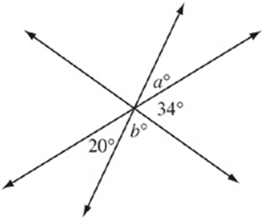
2. In the figure above, three lines intersect in a single point. What is the value of a + b?
(A) 20
(B) 54
(C) 126
(D) 146
(E) 252
3. If  , and
, and ![]() , what is the value of x?
, what is the value of x?
![]()
![]()
![]()
![]()
![]()
4. Two positive integers are “compatible” if their greatest common factor is a prime number. For instance, 15 and 25 are compatible because their greatest common factor is 5, which is prime. If m and 98 are compatible, and m is an odd number, then what is the greatest common factor of mand 98?
(A) 2
(B) 5
(C) 7
(D) 14
(E) 49
5. For how many integer values of k is ![]() ?
?
(A) 17
(B) 18
(C) 19
(D) 20
(E) 21
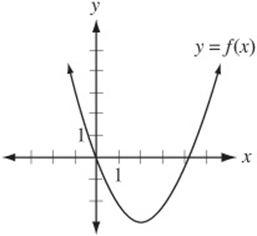
6. The figure above shows the graph of a quadratic function f that has a minimum value when ![]() . If
. If ![]() , then which of the following could be the value of k?
, then which of the following could be the value of k?
(A) –1
(B) 1
(C) 2
(D) 3
(E) 4
7. If m and n are integers and ![]() , what is the value of
, what is the value of ![]() ?
?
(A) 4
(B) 8
(C) 12
(D) 16
(E) 32
8. Amanda travels to work from home in 60 minutes. If, on her way home, she increases her average speed by 20% and she travels by the exact same route, how many minutes will it take her to get home?
(A) 48
(B) 50
(C) 54
(D) 60
(E) 64
Directions: For Student-Produced Response questions 9–18, use the grids at the bottom of the answer sheet page on which you have answered questions 1–8.
Each of the remaining 10 questions requires you to solve the problem and enter your answer by marking the circles in the special grid, as shown in the examples below. You may use any available space for scratchwork.
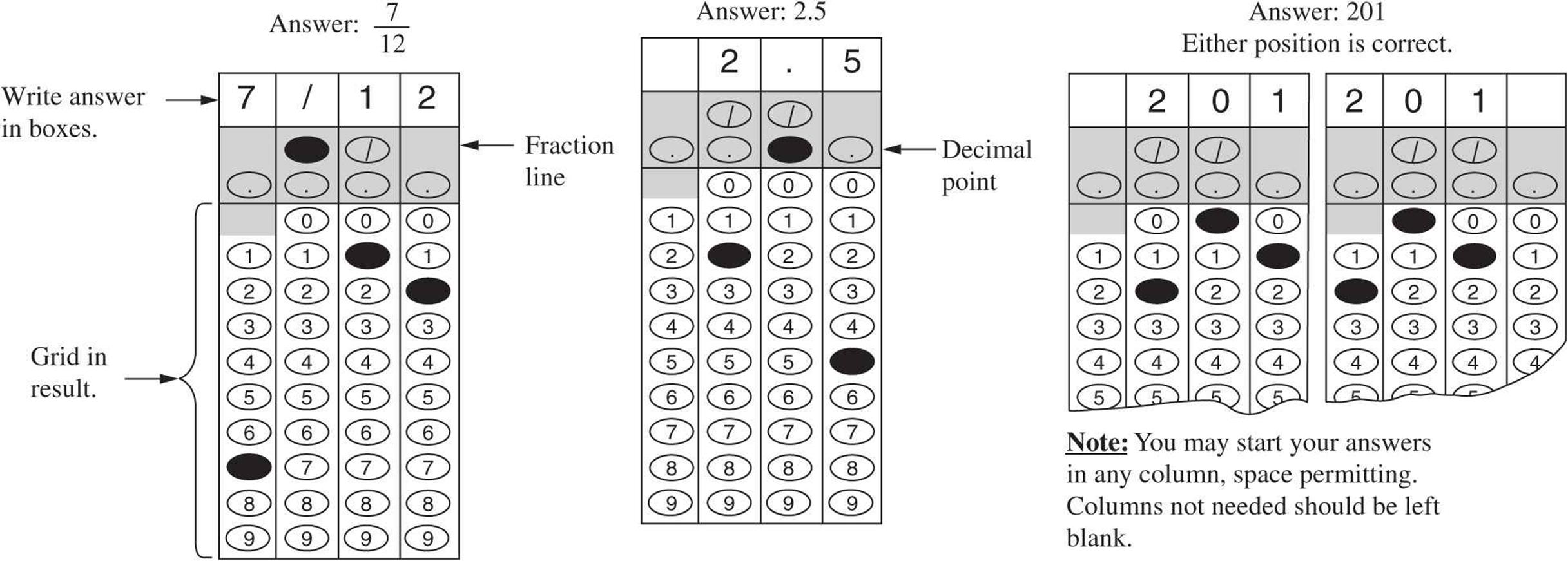
• Mark no more than one circle in any column.
• Because the answer sheet will be machine-scored, you will receive credit only if the circles are filled in correctly.
• Although not required, it is suggested that you write your answer in the boxes at the top of the columns to help you fill in the circles accurately.
• Some problems may have more than one correct answer. In such cases, grid only one answer.
• No question has a negative answer.
• Mixed numbers such as ![]() must be gridded as 3.5 or 7/2. (If
must be gridded as 3.5 or 7/2. (If  is gridded, it will be interpreted as,
is gridded, it will be interpreted as, ![]() not
not ![]() .)
.)
• Decimal Answers: If you obtain a decimal answer with more digits than the grid can accommodate, it may be either rounded or truncated, but it must fill the entire grid. For example, if you obtain an answer such as 0.6666…, you should record your result as .666 or .667. A less accurate value such as .66 or .67 will be scored as incorrect.
Acceptable ways to grid ![]() are:
are:
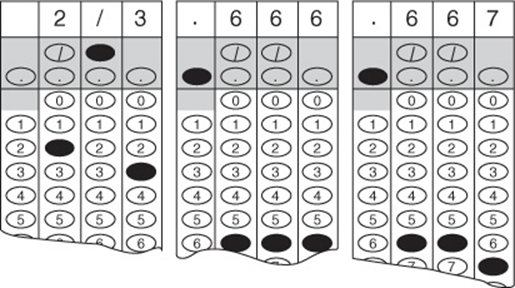
9. What is 0.5% of 80?
10. If d is the middle number of three consecutive odd integers whose sum is s, what is the value of d divided by s?
11. If ![]() of c2 is 24, what is
of c2 is 24, what is ![]() of c2?
of c2?
12. The measures of the four angles in a quadrilateral have a ratio of 3:4:5:6. What is the measure, in degrees, of the smallest of these angles?
13. If ![]() and
and ![]() , then what is the value of
, then what is the value of ![]() ?
?
14. If ![]() , what is the value of
, what is the value of 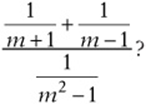
15. If x and y are positive integers such that ![]() , then what is the value of
, then what is the value of ![]() ?
?
16. A jar contains fifteen marbles, five of which are white and the rest black. What is the least number of white marbles that must be added to the jar so that at least three-fifths of the marbles will be white?
NUMBER OF BOOKS READ DURING SUMMER VACATION
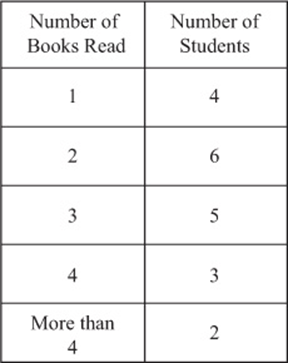
17. The table above shows the number of books 20 students read over their summer vacation. What is the median number of books read by these students?
18. In one basketball game, Tamara made 50% of her shots, and in the next game, she made 60% of her shots. In the two games, she made 52% of her shots altogether. If she took a shots in the first game and b shots in the second game, what is the value of ![]() ?
?

If you finish before time is called, you may check your work on this section only. Do not turn to any other section of the test.
SECTION 6
Time—25 minutes
24 questions
Turn to Section 6 of your answer sheet to answer the questions in this section.
Directions: For each question in this section, select the best answer from among the choices given and fill in the corresponding circle on the answer sheet.
Each sentence below has one or two blanks, each blank indicating that something has been omitted. Beneath the sentence are five words or sets of words labeled A through E. Choose the word or set of words that, when inserted in the sentence, best fits the meaning of the sentence as a whole.
EXAMPLE:
Rather than accepting the theory unquestioningly, Deborah regarded it with -----.
(A) mirth
(B) sadness
(C) responsibility
(D) ignorance
(E) skepticism
![]()
1. Rather than giving Sandra thoughtful and useful advice, her father admonished her with hollow clichés and ------- platitudes.
(A) irate
(B) inane
(C) homogeneous
(D) flamboyant
(E) altruistic
2. Maintaining a courageous ------- even while in prison, Nelson Mandela spent years trying to convince others that his fight against apartheid was not -------.
(A) optimism . . worthwhile
(B) will . . treacherous
(C) hope . . futile
(D) fortitude . . premeditated
(E) instability . . porous
3. The ------- of the construction near the building rendered the school far less ------- to learning; the teachers could hardly hear themselves talk.
(A) din . . conducive
(B) efficiency . . accustomed
(C) noise . . averse
(D) precision . . discernible
(E) racket . . irascible
4. Although no real problem in physics can be solved -------, an approximate solution by a simplified method is sufficient so long as the complicating factors are -------.
(A) precisely . . large
(B) completely . . difficult
(C) exactly . . negligible
(D) plausibly . . minimal
(E) ethically . . nonexistent
5. The ------- of a civil war depends on the factions” access to martial resources; the conflict may drag on for years or even decades so long as each side has sufficient ------- to continue fighting.
(A) violence . . mediation
(B) popularity . . opposition
(C) length . . reluctance
(D) duration . . means
(E) value . . skill
The passages below are followed by questions based on their content. Answer the questions on the basis of what is stated or implied in the passage and in any introductory material that may be provided.
Questions 6 and 7 are based on the following passage.
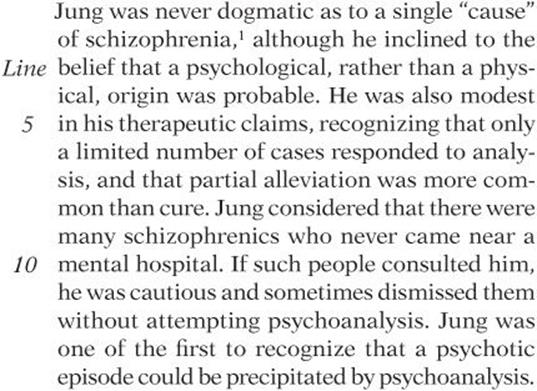
6. According to the passage, with which of the following statements would Jung most likely agree?
(A) Schizophrenia is much more common than most psychologists acknowledge.
(B) Schizophrenia has a single common cause.
(C) Psychoanalysis is not helpful to all mentally ill patients.
(D) Schizophrenia might be caused by physical trauma.
(E) Psychoanalysis, in the right measure, can cure all schizophrenic patients.
7. As it is used in line 14, “precipitated by” most nearly means
(A) hastened by
(B) cured by
(C) responsive to
(D) made more efficient by
(E) composed of
Questions 8 and 9 are based on the following passage.
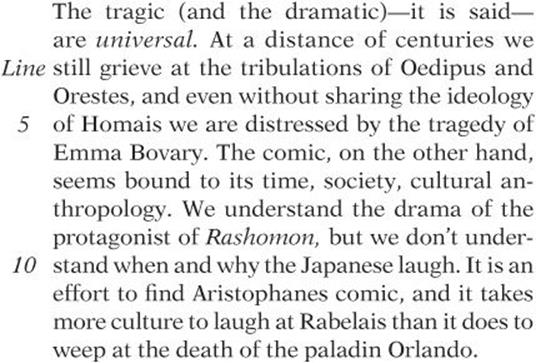
First passage: Anthony Storr, The Essential Jung. Copyright © 1983 by Princeton University Press. Reprinted by permission of Princeton University Press.
Second passage: The Comic and the Rule in Travels in Hyperreality, by Umberto Eco, Harcourt, Brace, Jovanovich, © 1983.
8. Which of the following would the author consider most difficult for a modern American to find humorous?
(A) a farcical musical about animals who talk
(B) a comic film about gangsters set in Chicago
(C) a satirical poem written in 16th-century China
(D) a situation comedy based on the life of a plumber
(E) a funny movie with a tragic ending
9. The “effort” (line 11) to which the author refers is a task that requires which of the following?
(A) great planning
(B) the work of more than one person
(C) overcoming cultural obstacles
(D) a great many natural resources
(E) emotional fortitude
Questions 10–16 are based on the following passage.
The following is an excerpt from a book on the writing process in which the author describes an interview he gave by telephone to a radio show to promote a writer”s conference.
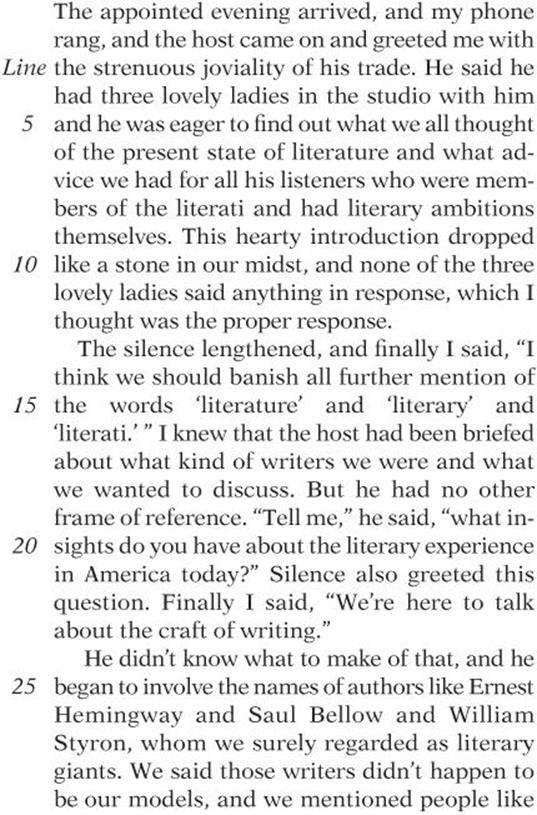
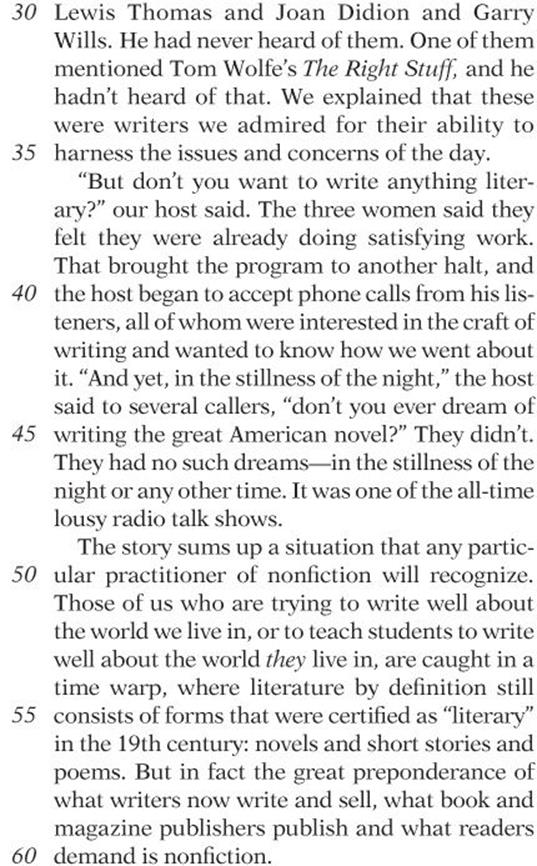
Excerpted from On Writing Well, Copyright © 1976, 1980, 1985, 1988, 1990, 1994, 1998, by William Zinsser. Reprinted with permission of the author.
10. In the first paragraph, the author suggests that he regards the host”s introduction to be
(A) insincere
(B) inappropriate
(C) erudite
(D) flattering
(E) incoherent
11. Throughout the passage, the author uses the term “literary” to mean
(A) well-written
(B) with regard to love stories
(C) pertaining to the writing of fiction and poetry
(D) concerning contemporary issues
(E) persuasive
12. What is the main substance of the misunderstanding between the interviewer and the interviewees?
(A) The interviewer believed that the writers had written books that they actually had not.
(B) The interviewer lacked a frame of reference on writing beyond literary fiction.
(C) The interviewees wanted to be more critical of classic authors, while the interviewer wanted to praise them.
(D) The interviewer wanted to discuss current issues, while the writers wanted to discuss 19th-century literary forms.
(E) The interviewer disagreed with the writers on the merits of The Right Stuff.
13. The authors in lines 30–31 are mentioned as examples of
(A) the most popular authors of the time
(B) authors who had set the trend for the “literary” style of that era
(C) authors who had influenced the work of the writers being interviewed
(D) authors whose works followed in the manner of Hemingway, Bellow, and Styron
(E) authors who wrote experimental fiction
14. In context, the word “harness” (line 35) most nearly means
(A) dominate
(B) make easier to understand
(C) influence the direction of
(D) witness
(E) reinforce
15. If the callers shared the sensibilities of the interviewees, then by saying that they had “no such dreams” (line 46), the callers were most likely suggesting that they
(A) did not wish to pursue literary fame in such a competitive environment
(B) had disdain for those who wrote fiction for profit
(C) knew that the public did not care for writers like Thomas, Didion, and Wills
(D) had been discouraged by their negative experiences with publishers in the literary world
(E) were happy doing what they were doing
16. In context, the word “preponderance” (line 57) most nearly means
(A) evidence
(B) domination
(C) majority
(D) heaviness
(E) quality
Questions 17–24 are based on the following passage.
The following is from a book on the history of Western philosophy by Bertrand Russell, in which he discusses ancient Greek philosophy.
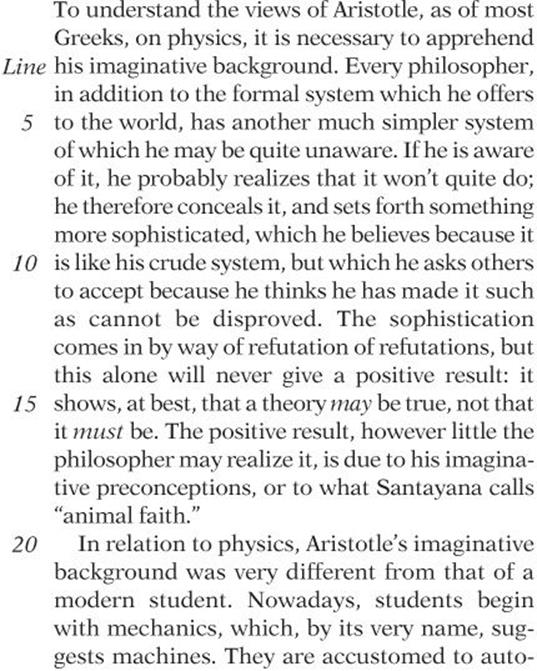
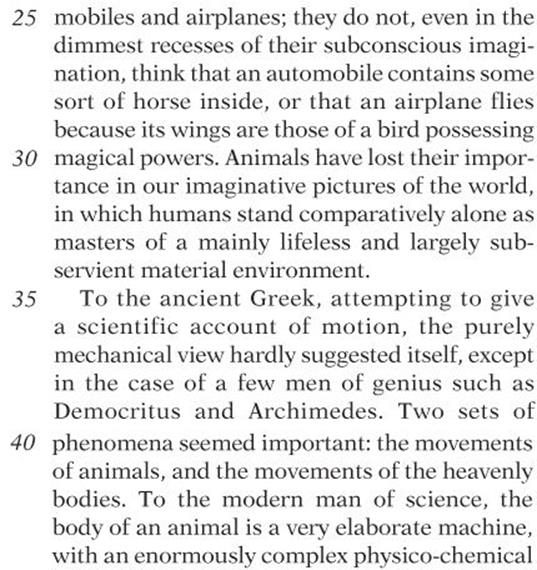
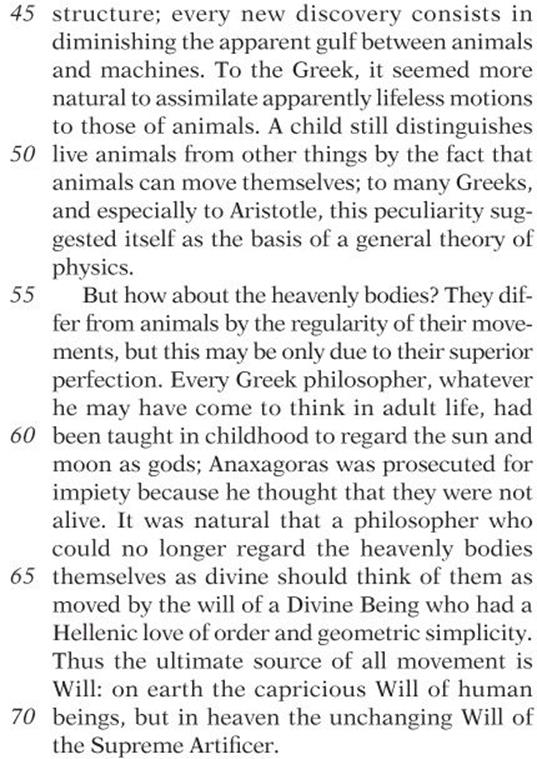
Excerpted from A History of Western Philosophy, Copyright © 1945 by Bertrand Russell, Copyright © renewed 1973 by Edith Russell. Reprinted with permission of Simon & Schuster Adult Publishing Group.
17. Which of the following best summarizes the overall purpose of this passage?
(A) to compare Aristotle”s philosophy with those of Democritus and Archimedes
(B) to describe the preconceptions behind Aristotle”s physical theories
(C) to uncover the flaws in ancient Greek astronomy
(D) to show how Aristotle”s theories facilitated the development of modern technology
(E) to contrast the modern conception of the animal with that of the ancient Greeks
18. According to the passage, in what way have animals “lost their importance” (lines 30–31)?
(A) Humans no longer treat animals as respectfully as they once did.
(B) Humans no longer need animals to do hard labor.
(C) Few religions today require animal sacrifices.
(D) Modern writers rarely write stories or fables with animals as main characters.
(E) Animals no longer inspire modern physical theories.
19. Which of the following is most similar to the “imaginative preconceptions” (lines 17–18) of Aristotle?
(A) the belief that animals are inferior to humans
(B) the belief that all scientific problems can be solved through rigorous philosophical analysis
(C) the belief that computers have minds and souls like humans or animals
(D) the belief that the body of an animal is a complicated machine
(E) the belief that the sun and moon are not alive
20. What does the author imply about the “men of genius” (line 38)?
(A) They believed that physics is essentially the study of the mechanics of motion rather than spirits or wills.
(B) They were able to precisely determine the orbits of the planets.
(C) They regarded the sun and moon as gods.
(D) They alone saw the similarity between the motion of animals and the motion of heavenly bodies.
(E) They regarded all movement as being produced by a Divine Being.
21. According to the passage, modern scientists diminish “the apparent gulf between animals and machines” (lines 46–47) by
(A) using machines to train animals
(B) studying the motivations of animals
(C) working to make machines function more like animals
(D) using technology to improve the lives of animals
(E) uncovering the mechanical laws behind biology
22. In line 48, the word “assimilate” most nearly means
(A) compare
(B) repeat
(C) attach
(D) refer
(E) elevate
23. In the final paragraph, which of the following does the author imply about Greek philosophers?
(A) Some of them were not rigorous in demonstrating their theories through experiment.
(B) They were more concerned with popularizing their theories than proving them.
(C) Some of them departed dramatically from their childhood teachings.
(D) They all regarded the planetary bodies as divine.
(E) Most of them disagreed strongly with Aristotle.
24. The “Hellenic love of order and geometric simplicity” (line 67) attributed to the “Divine Being” (line 66) can be inferred to involve which of the following?
I. a need to simplify mathematical equations
II. a desire to make astronomical objects move in elegant paths
III. a need to unify the laws of motion with a single theory
(A) I only
(B) II only
(C) I and II only
(D) I and III only
(E) I, II, and III

If you finish before time is called, you may check your work on this section only. Do not turn to any other section of the test.
SECTION 7
Time—20 minutes
16 questions
Turn to Section 7 of your answer sheet to answer the questions in this section.
Directions: For this section, solve each problem and decide which is the best of the choices given. Fill in the corresponding circle on the answer sheet. You may use any available space for scratchwork.
Notes
1. The use of a calculator is permitted.
2. All numbers used are real numbers.
3. Figures that accompany problems in this test are intended to provide information useful in solving the problems. They are drawn as accurately as possible EXCEPT when it is stated in a specific problem that the figure is not drawn to scale. All figures lie in a plane unless otherwise indicated.
4. Unless otherwise specified, the domain of any function f is assumed to be the set of all real numbers x for which f (x) is a real number.
Reference Information

The number of degrees of arc in a circle is 360.
The sum of the measures in degrees of the angles of a triangle is 180.
1. The number that is ![]() of 60 is what fraction of 80?
of 60 is what fraction of 80?
![]()
![]()
![]()
![]()
![]()
2. If ![]() , then
, then ![]()
(A) 0.25
(B) 0.5
(C) 1
(D) 2
(E) 4
3. 29 apples, 21 pears, and 64 oranges are to be distributed among three baskets, with each basket getting an equal number of apples, each basket getting an equal number of pears, and each basket getting an equal number of oranges. If as much of the fruit as possible is distributed in this way, what fruit will remain undistributed?
(A) 2 apples, 2 pears, and 1 orange
(B) 2 apples, 1 pear, and 1 orange
(C) 2 apples and 1 orange
(D) 1 pear and 1 orange
(E) 1 apple only
4. For all values of x and y, let x & y be defined by the equation ![]() . What is the value of 1 & 2?
. What is the value of 1 & 2?
(A) 1
(B) 2
(C) 3
(D) 4
(E) 5
5. In ΔABC, ![]() and
and ![]() . Which of the following could not be the length of AC?
. Which of the following could not be the length of AC?
(A) 5
(B) 7
(C) 9
(D) 16
(E) 22
6. What is the surface area of a cube that has a volume of 64 cubic centimeters?
(A) 64 square centimeters
(B) 96 square centimeters
(C) 256 square centimeters
(D) 288 square centimeters
(E) 384 square centimeters
7. The average (arithmetic mean) of x, 2, 6, and 10 is 8. What is the median of x, 2, 6, and 10?
(A) 4
(B) 6
(C) 7
(D) 8
(E) 9
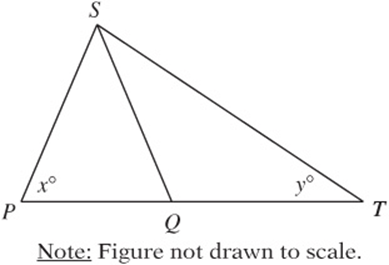
8. In the figure above, ![]() and
and ![]() . Which of the following expresses y in terms of x?
. Which of the following expresses y in terms of x?
![]()
![]()
![]()
![]()
![]()
![]()
9. The graph above represents the set of all possible solutions to which of the following statements?
![]()
![]()
![]()
![]()
![]()

10. If a, b, and c represent different integers in the statements above, which of the following statements must be true?
![]()
![]()
![]()
(A) I only
(B) II only
(C) I and II only
(D) I and III only
(E) I, II, and III
11. How many different positive three-digit integers begin with an odd digit and end with an even digit?
(A) 125
(B) 180
(C) 200
(D) 225
(E) 250
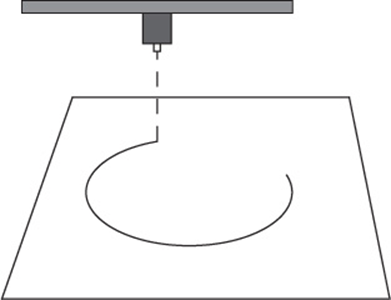
12. A machine uses a laser beam to cut circles from a sheet of plastic, as shown in the figure above. The beam cuts at the rate of 3 cm per second. If circle A has an area of 64π square centimeters and circle B has an area of 16π square centimeters, how many more seconds will it take the machine to cut circle A than circle B?
(A) 2π seconds
![]()
![]()
(D) 8π seconds
![]()
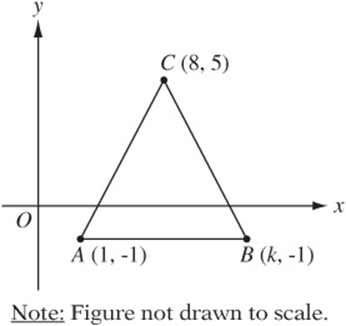
13. In the figure above, the slope of AC is the opposite of the slope of CB. What is the value of k?
(A) 9
(B) 10
(C) 12
(D) 14
(E) 15
14. If m is the product of all of the integers from 1 to 10, inclusive, and 2n is a factor of m, then what is the greatest possible value of n?
(A) 2
(B) 4
(C) 8
(D) 16
(E) 32
15. An equilateral triangle with area ![]() square centimeters is divided into two triangles by the bisector of one of its angles. What is the sum of the perimeters of these two triangles?
square centimeters is divided into two triangles by the bisector of one of its angles. What is the sum of the perimeters of these two triangles?
![]()
![]()
![]()
![]()
![]()
16. A culture of bacteria doubles in population every 2 hours. A sample of 100 bacteria grows to 1,000 bacteria by 4:00 p.m. At what time were there 250 bacteria in this sample?
(A) 11:30 am
(B) 12 noon
(C) 12:30 pm
(D) 1:00 pm
(E) 2:00 pm

If you finish before time is called, you may check your work on this section only. Do not turn to any other section of the test.
SECTION 8
Time—20 minutes
19 questions
Turn to Section 8 of your answer sheet to answer the questions in this section.
Directions: For each question in this section, select the best answer from among the choices given and fill in the corresponding circle on the answer sheet.
Each sentence below has one or two blanks, each blank indicating that something has been omitted. Beneath the sentence are five words or sets of words labeled A through E. Choose the word or set of words that, when inserted in the sentence, best fits the meaning of the sentence as a whole.
EXAMPLE:
Rather than accepting the theory unquestioningly, Deborah regarded it with-----.
(A) mirth
(B) sadness
(C) responsibility
(D) ignorance
(E) skepticism
![]()
1. To Clara”s relief, the biopsy revealed that the tumor on her skin was -------.
(A) malignant
(B) irreverent
(C) serene
(D) benign
(E) mortal
2. The speaker”s message was ------- by jargon that rendered it decipherable only to those few audience members familiar with her particular area of expertise.
(A) elated
(B) revealed
(C) obscured
(D) enlightened
(E) consoled
3. To those consumers who are more influenced by style than by performance, the ------- value of the sports car outweighs its functional flaws.
(A) utilitarian
(B) pragmatic
(C) approximate
(D) aesthetic
(E) inexplicable
4. A student becomes a thinker only when he or she realizes that most so-called facts are merely ------- claims, each serving its purpose only temporarily.
(A) provisional
(B) polemical
(C) authoritative
(D) dramatic
(E) pedantic
5. Traditionally, the role had been played demurely to provide a foil for the bolder personalities in the play, but Ms. Linney has decided to ------- convention and emphasize her character”s -------.
(A) respect . . bluster
(B) abandon . . solitude
(C) forgo . . coyness
(D) uphold . . bombast
(E) eschew . . impudence
6. Despite the attempts of popular analysts to depict the stock market as driven by predictable financial principles, an increasing number of investors believe that the price of any security is -------.
(A) invaluable
(B) complacent
(C) capricious
(D) responsive
(E) obscure
The passages below are followed by questions based on their content; questions following a pair of related passages may also be based on the relationship between the paired passages. Answer the questions on the basis of what is stated or implied in the passage and in any introductory material that may be provided.
Questions 7–19 are based on the following passages.
Since 1996, when scientists at the Roslin Institute in England cloned a sheep from the cells of another adult sheep, many inside and outside the scientific community have debated the ethics of cloning the cells of human beings. The following passages are excerpts of arguments on this issue.
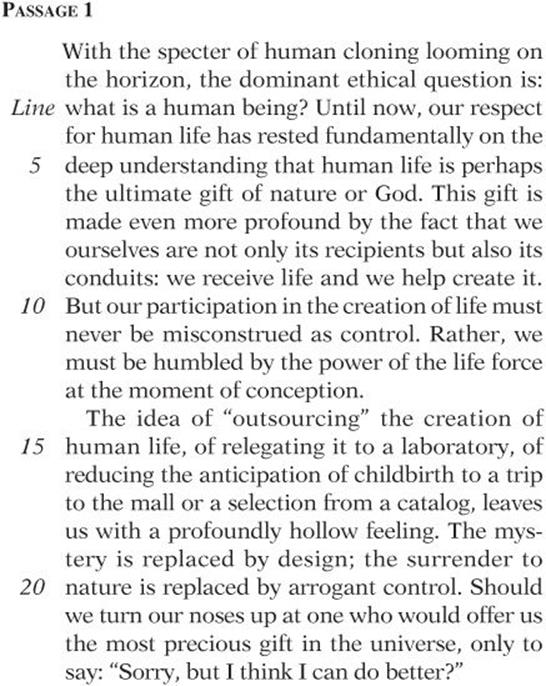
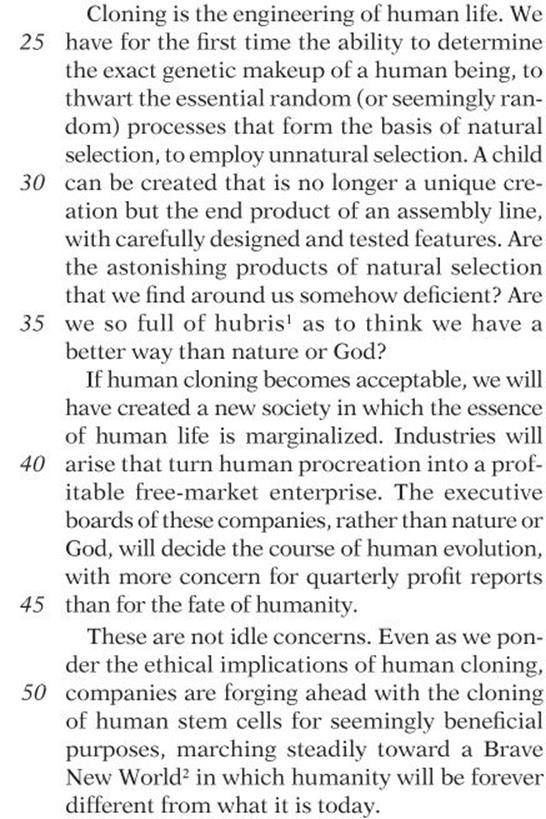
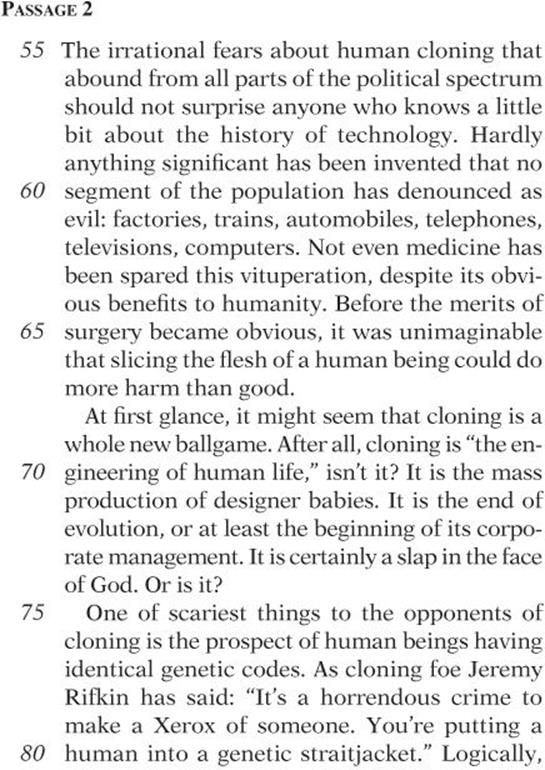
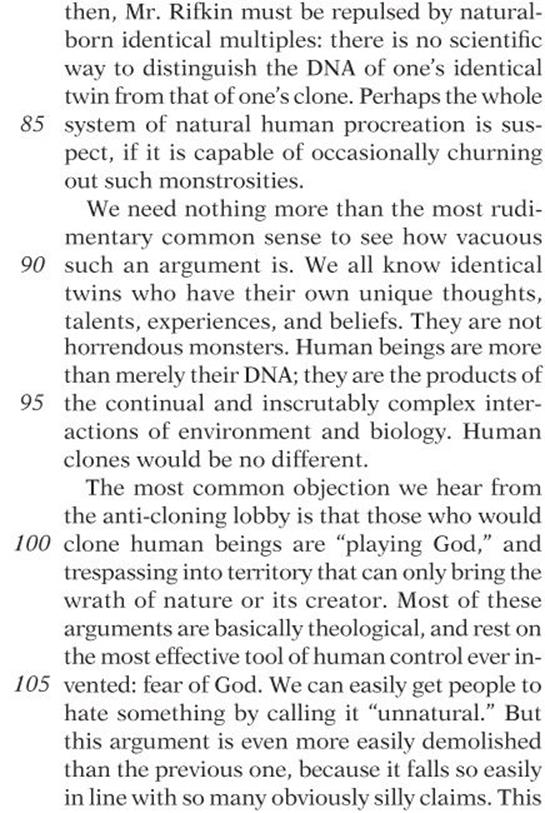
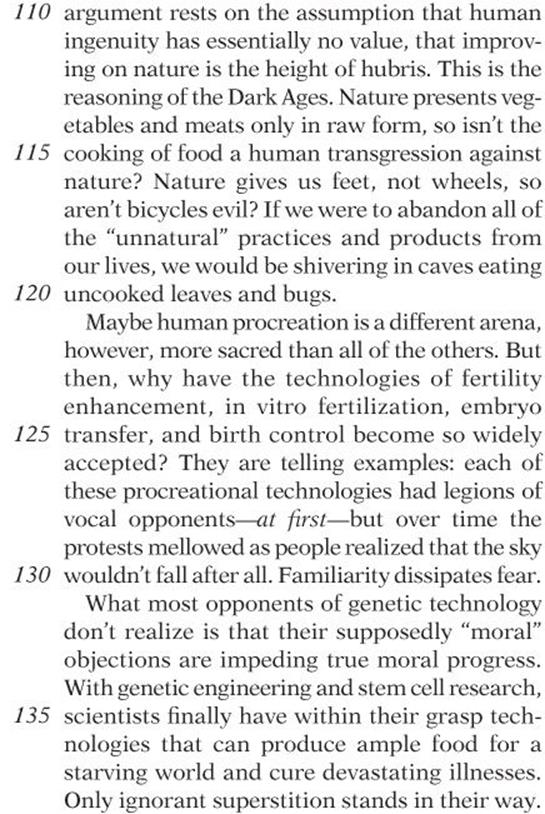
7. The “control” mentioned in line 11 is control over
(A) the effects of cloning
(B) the development of genetic technologies
(C) the process of conception
(D) the moral debate about cloning
(E) activities in a laboratory
8. Which of the following best describes the attitude of the author of Passage 1 toward “outsourcing” (line 14)?
(A) reluctant approval
(B) disdain
(C) strong support
(D) ironic detachment
(E) ambivalence
9. The statement “sorry, but I think I can do better” (line 23) is intended to represent a comment from
(A) a religious person to a nonreligious person
(B) an opponent of cloning to a scientist
(C) a voter to a politician
(D) the author to the reader
(E) an advocate of cloning to nature or God
10. The parenthetical comment in lines 27–28 is intended to account for the possibility that
(A) life might be designed by a power beyond humanity
(B) cloning technologies might become uncontrollable
(C) two human beings might have the same genetic makeup by chance alone
(D) some scientific theories might not be reliable
(E) cloning technology might not succeed
11. Passage 1 mentions which of the following as elements of “unnatural selection” (line 29)?
I. mechanical procedures
II. random processes
III. selection of characteristics
(A) I only
(B) III only
(C) I and II only
(D) I and III only
(E) I, II, and III
12. In the first paragraph of Passage 2, the author suggests that the opponents of human cloning, as a group, are all of the following EXCEPT
(A) very religious
(B) unreasonable about the implications of cloning
(C) from widely varied political orientations
(D) ignorant of scientific history
(E) fearful of new ideas
13. Surgery is mentioned in lines 62–65 as an example of
(A) a practice that requires a great deal of education
(B) something that most people still fear
(C) a medical technology that was once denounced
(D) a viable alternative to genetic technologies
(E) a skill in need of more practitioners
14. The author of Passage 2 quotes Jeremy Rifkin (lines 76–78) in order to
(A) illustrate the dangers of cloning
(B) show a well-reasoned perspective
(C) indicate an illogical claim
(D) represent the views of medical professionals
(E) show how others support the author”s thesis
15. The author of Passage 2 mentions that identical human twins “have their own unique thoughts” (line 89) in order to suggest that those twins
(A) would likely oppose human cloning
(B) are not simply the product of their DNA
(C) are among the most vocal advocates of cloning
(D) are able to provide alternatives to procreational technologies
(E) are less likely to be swayed by illogical theories
16. Passage 2 suggests that those individuals who had previously denounced “procreational technologies” (line 125) have since come to accept them because those individuals
(A) became more familiar with the technologies
(B) realized that the technologies were indeed “natural”
(C) understood the theories behind the technologies
(D) realized that the technologies were inexpensive
(E) themselves needed to use those technologies
17. The tone of the last paragraph of Passage 2 is best described as
(A) indignant
(B) analytical
(C) resigned
(D) humorous
(E) whimsical
18. Which of the following best describes the relationship between the pair of questions presented in Passage 1 (“Are the astonishing products … nature or God?” [lines 32–36]) and the pair of questions presented in Passage 2 (“Nature presents … evil?” [lines 111–115])?
(A) The first two are not intended to be answered, while the second two are.
(B) The first two are scientific questions, while the second two are moral questions.
(C) Both pairs of questions indicate points of view criticized by their respective authors.
(D) The first two are intended as questions from cloning opponents, while the second two are intended as questions from cloning advocates.
(E) The first two are common questions, the second two are asked only by experts.
19. The last paragraphs of both passages indicate that both authors share what assumption?
(A) Cloning needs more scientific study.
(B) Genetic engineering will have profound global effects.
(C) Cloning will marginalize human life.
(D) Procreational technology can benefit the poor.
(E) Scientists are ill-suited to make moral decisions.

If you finish before time is called, you may check your work on this section only. Do not turn to any other section of the test.
SECTION 9
Time—10 minutes
14 questions
Turn to Section 9 of your answer sheet to answer the questions in this section.
Directions: For each question in this section, select the best answer from among the choices given and fill in the corresponding circle on the answer sheet.
The following sentences test correctness and effectiveness of expression. Part of each sentence or the entire sentence is underlined; beneath each sentence are five ways of phrasing the underlined material. Choice A repeats the original phrasing; the other four choices are different. Select the choice that completes the sentence most effectively.
In making your selection, follow the requirements of standard written English; that is, pay attention to grammar, choice of words, sentence construction, and punctuation. Your selection should result in the most effective sentence—clear and precise, without awkwardness or ambiguity.
EXAMPLE:
The children couldn”t hardly believe their eyes.
(A) couldn”t hardly believe their eyes
(B) could hardly believe their eyes
(C) would not hardly believe their eyes
(D) couldn”t nearly believe their eyes
(E) couldn”t hardly believe his or her eyes
![]()
1. One way to improve the effectiveness of the treatment is by moving the source of radiation more closely to the patient.
(A) by moving the source of radiation more closely
(B) to move the source of radiation more closely
(C) to move the source of radiation closer
(D) in moving the source of radiation closer
(E) to move more closely the source of radiation
2. Until becoming more affordable by standardizing its technology, cell phones were quite rare.
(A) Until becoming more affordable by standardizing its technology
(B) Having become more affordable through standardizing their technology
(C) Becoming more affordable through standardized technology
(D) Until they became more affordable in standardized technology
(E) Until standardized technology made them more affordable
3. The airline industry has adopted new pricing procedures; seeming to benefit both the consumers as well as the companies.
(A) procedures; seeming to benefit both the consumers as well as
(B) procedures; seemingly benefitting both the consumers and
(C) procedures seemingly in benefit of both the consumers as well as
(D) procedures that seem benefitting of both the consumers and
(E) procedures that seem to benefit both the consumers and
4. The thirty-foot-high stone wall, built over the course of eighty years, once protecting the city from invaders.
(A) wall, built over the course of eighty years, once protecting
(B) wall, built over the course of eighty years, once protected
(C) wall was built over the course of eighty years, which protected
(D) wall was built over the course of eighty years in protecting
(E) wall, built over the course of eighty years; it once protected
5. A concise and informative guide for writers, William Zinsser”s On Writing Well has sold nearly one million copies.
(A) William Zinsser”s On Writing Well has sold nearly one million copies
(B) nearly one million copies of William Zinsser”s On Writing Well have been sold
(C) William Zinsser wrote On Writing Well, which has sold nearly one million copies
(D) William Zinsser”s On Writing Well having sold nearly one million copies
(E) On Writing Well has sold nearly one million copies by William Zinsser
6. When you submit personal information to a Web site, one should make sure that it won”t be used for unauthorized purposes.
(A) one should make sure
(B) and make sure
(C) then make sure
(D) be sure of
(E) make sure
7. Although passenger pigeons once filled the skies over Michigan, relentless hunting eliminated their entire population by 1901.
(A) relentless hunting eliminated their entire population by 1901
(B) it was relentless hunting eliminating their entire population by 1901
(C) its entire population was eliminated by relentless hunting by 1901
(D) by 1901 it was relentless hunting eliminating their entire population
(E) relentless hunting having eliminated their entire population by 1901
8. The failure of the relief effort was more a result of poor coordination than because of blatant corruption.
(A) poor coordination than because of blatant corruption
(B) coordination being poor than by blatant corruption
(C) poor coordination than by blatant corruption
(D) poor coordination than of blatant corruption
(E) coordination being poor than corruption being blatant
9. Until revealing that she had been working at a design firm, few of her friends realized that Amanda was interested in art.
(A) Until revealing that she had been working
(B) Having revealed that she had been working
(C) Until she revealed that she had been working
(D) Being that she revealed she had worked
(E) Until she revealed about her working
10. Inspired by reading about the great explorers, it was Gerald”s decision to sail around the world.
(A) it was Gerald”s decision to sail around the world
(B) Gerald decided to sail around the world
(C) the decision was made by Gerald to sail around the world
(D) sailing around the world was what Gerald decided to do
(E) Gerald having decided to sail around the world
11. The results of the election were so close that the club had it decided that they would have co-presidents.
(A) had it decided that they would have co-presidents
(B) decided to have co-presidents
(C) would have decided to have co-presidents
(D) decided they would have co-presidents
(E) had decided that they would have co-presidents
12. Writing skills are waning because the widespread use of e-mail and instant messaging discourages students from developing their ideas and supporting those ideas logically.
(A) messaging discourages students from developing their ideas and supporting
(B) messaging discourage students to develop their ideas and support
(C) messaging, which discourages students from developing their ideas and supporting
(D) messaging discouraging students from developing their ideas and supporting
(E) messaging discouraging students to develop their ideas and support
13. To acknowledge opposing viewpoints does not mean subverting your own thesis, and in fact usually creates a more cogent essay.
(A) To acknowledge
(B) In acknowledging
(C) Acknowledging
(D) While acknowledging
(E) For the acknowledgment of
14. To get the full benefit of any medication, avoid problems, and for the reduction of possible side effects, discuss your prescription with your doctor.
(A) for the reduction of possible side effects
(B) for reducing possible side effects
(C) reducing possible side effects
(D) also to reduce possible side effects
(E) reduce possible side effects

If you finish before time is called, you may check your work on this section only. Do not turn to any other section of the test.
ANSWER KEY
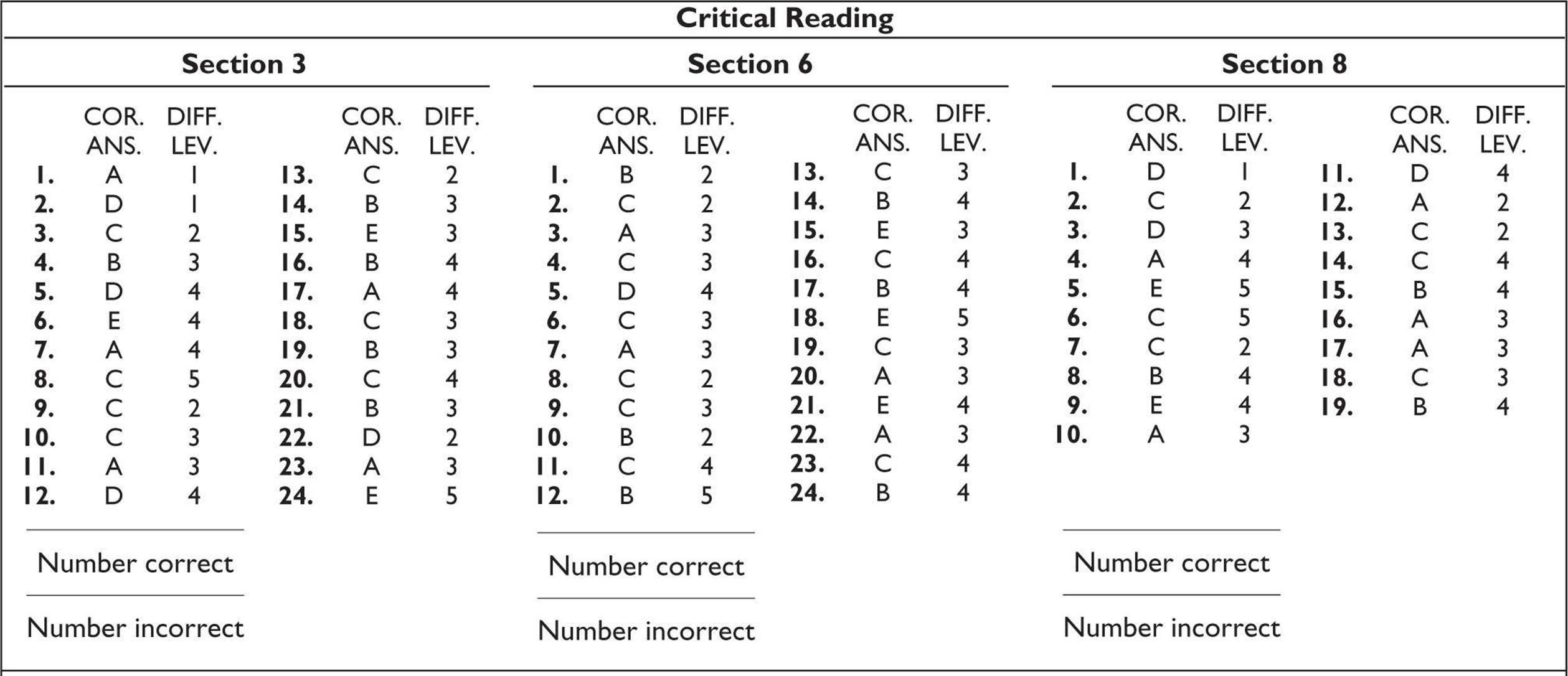
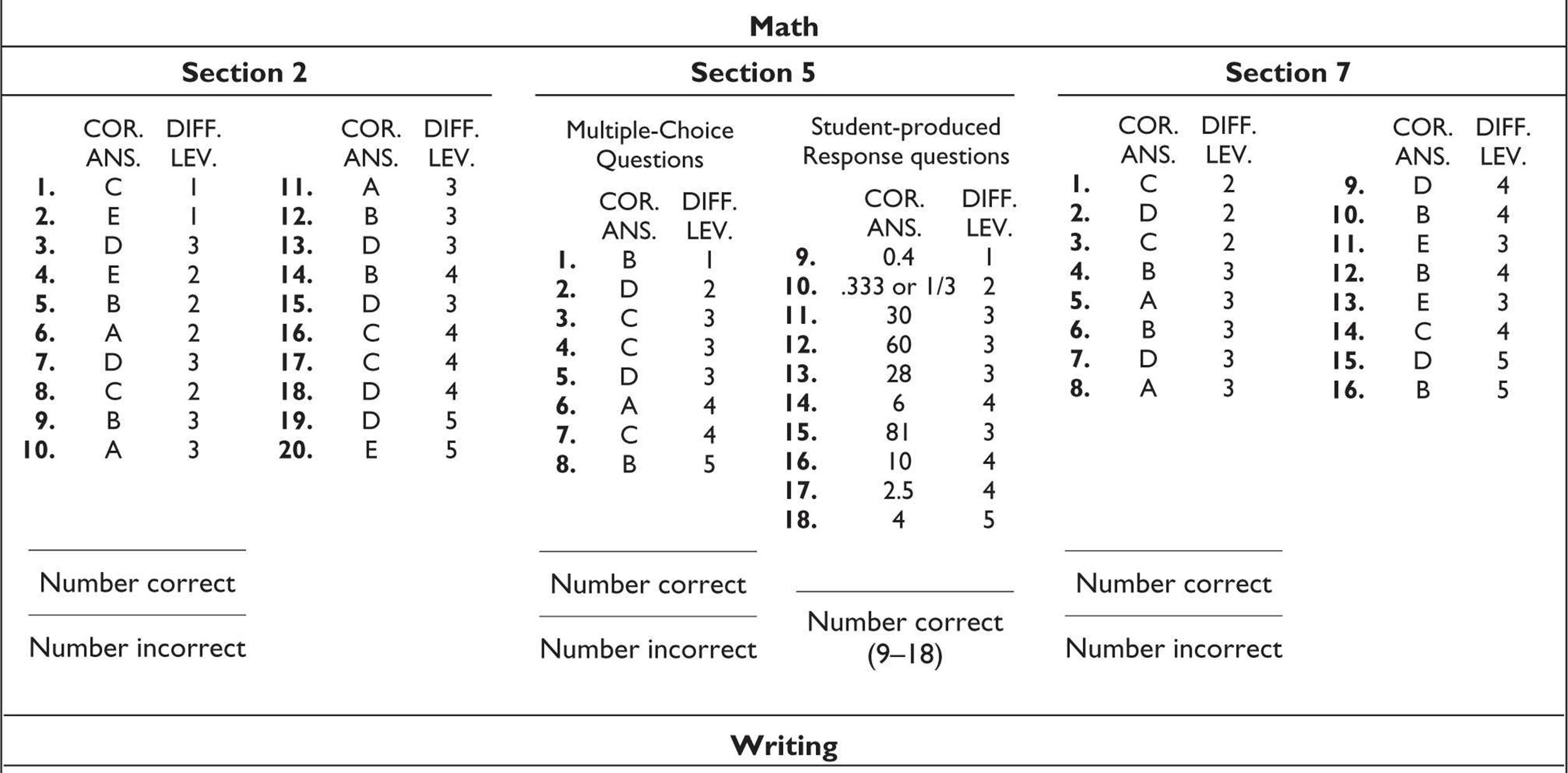
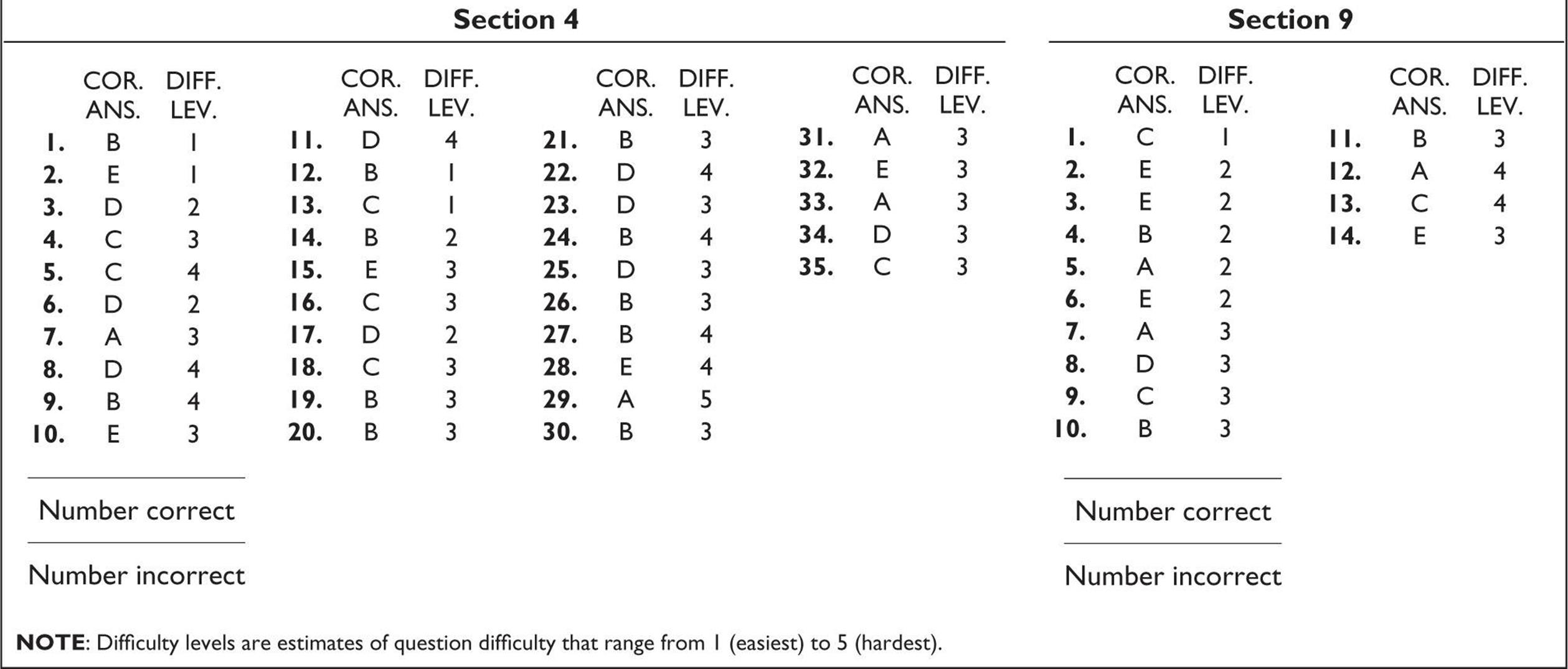
SCORE CONVERSION TABLE
How to score your test
Use the answer key on the previous page to determine your raw score on each section. Your raw score on each section except Section 5 is simply the number of correct answers minus ¼ of the number of wrong answers. On Section 5, your raw score is the sum of the number of correct answers for questions 1–8 minus ¼ of the number of wrong answers for questions 1–8 plus the total number of correct answers for questions 9–18. Next, add the raw scores from Sections 3, 6, and 8 to get your Critical Reading raw score, add the raw scores from Sections 2, 5, and 7 to get your Math raw score, and add the raw scores from Sections 4 and 9 to get your Writing raw score. Write the three raw scores here:
Raw Critical Reading score: ____________ Raw Math score: ____________ Raw Writing score: ___________
Use the table below to convert these to scaled scores.
Scaled scores: Critical Reading: _____________ Math: _____________ Writing: _____________
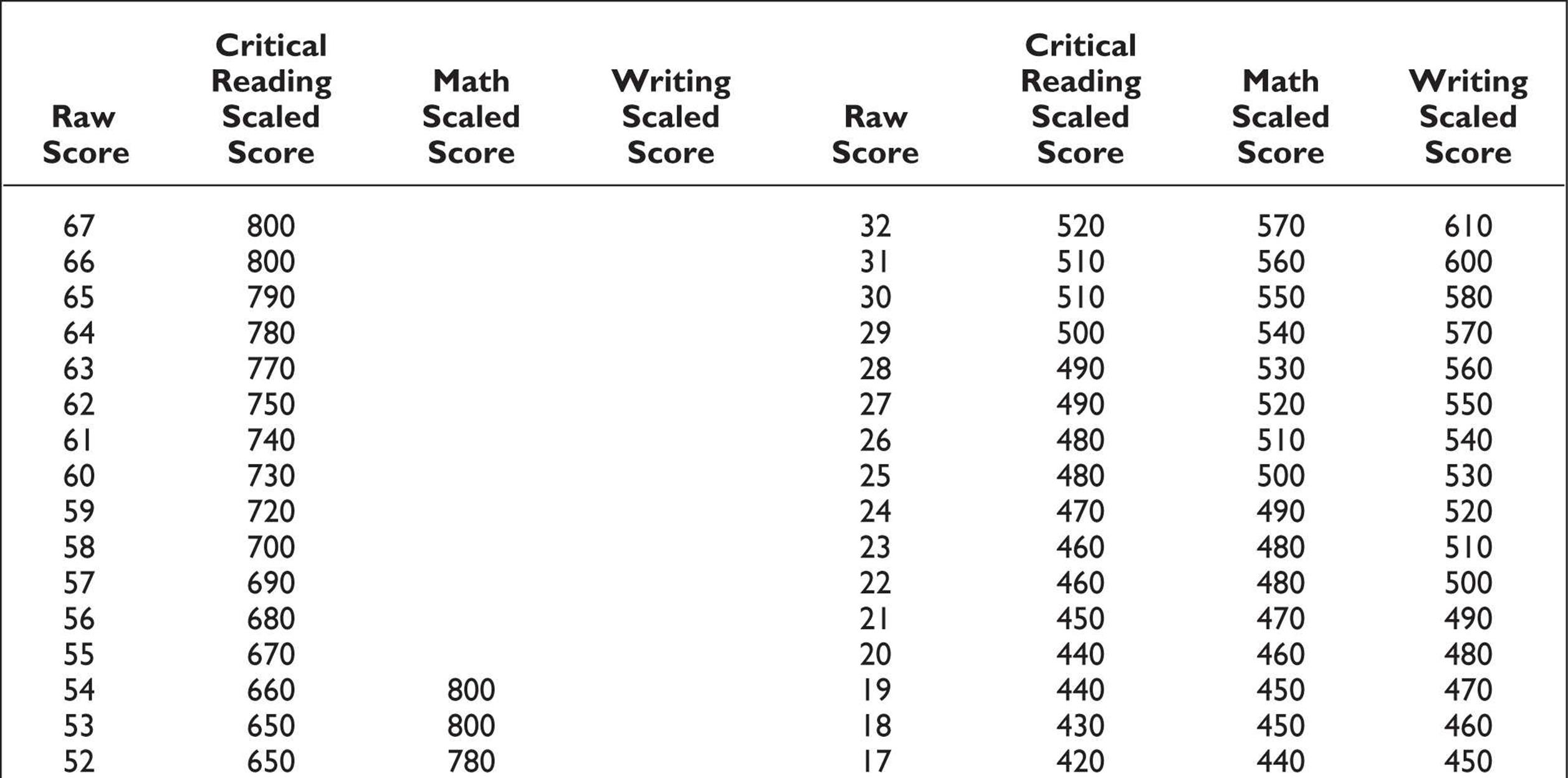
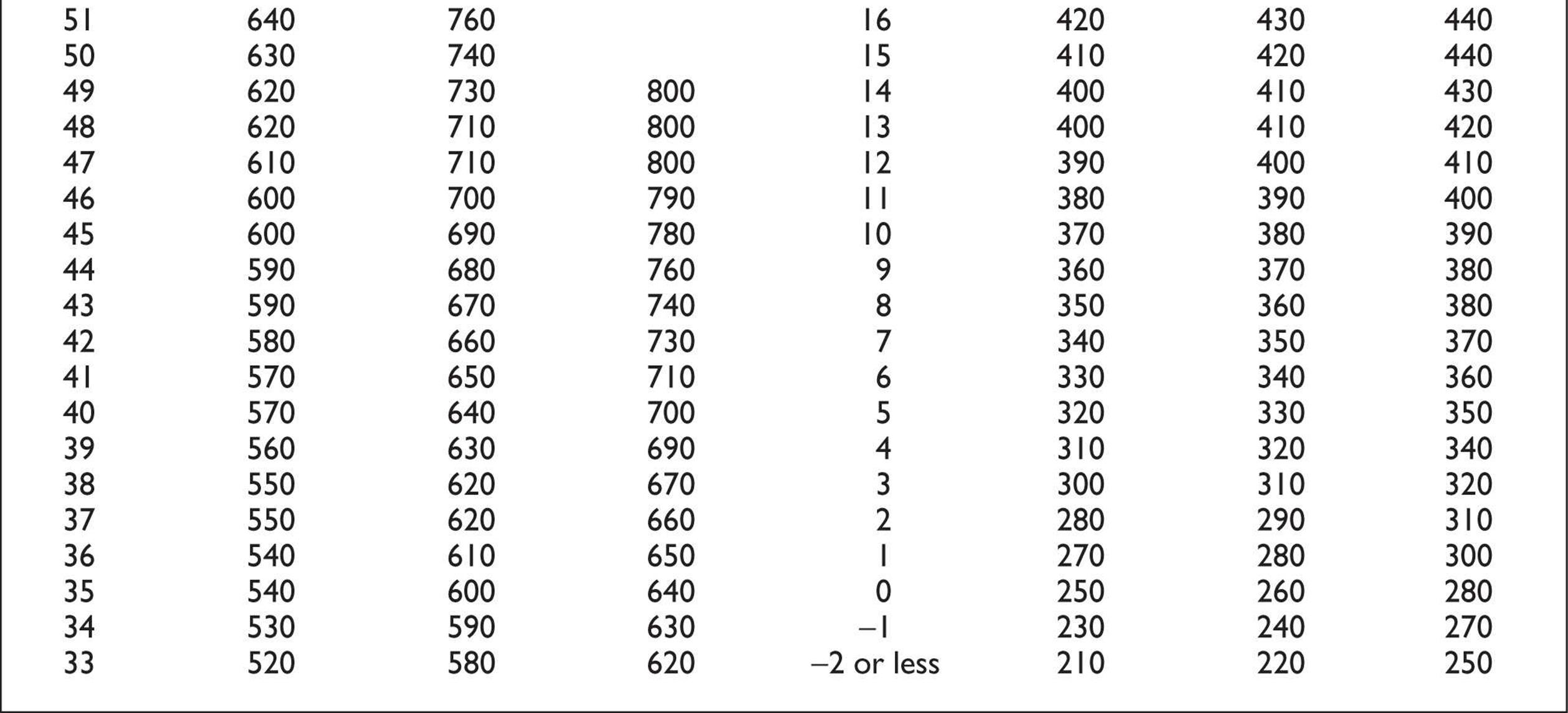
SCORE CONVERSION TABLE FOR WRITING COMPOSITE [ESSAY + MULTIPLE CHOICE]
Calculate your writing raw score as you did on the previous page, and grade your essay from a 1 to a 6 according to the standards that follow in the detailed answer key.
Essay score: ____________ Raw Writing score: ____________
Use the table below to convert these to scaled scores.
Scaled score: Writing: _____________
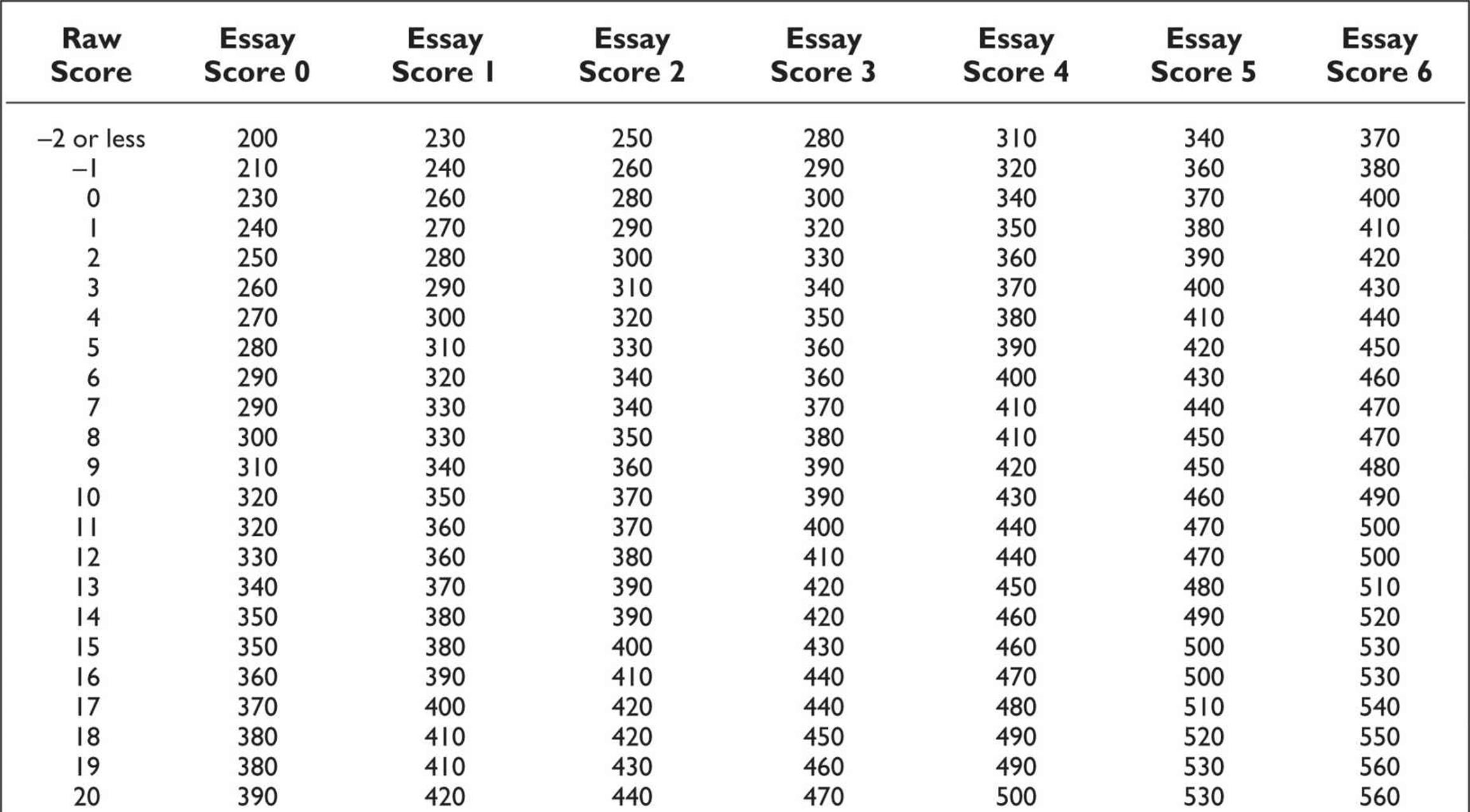
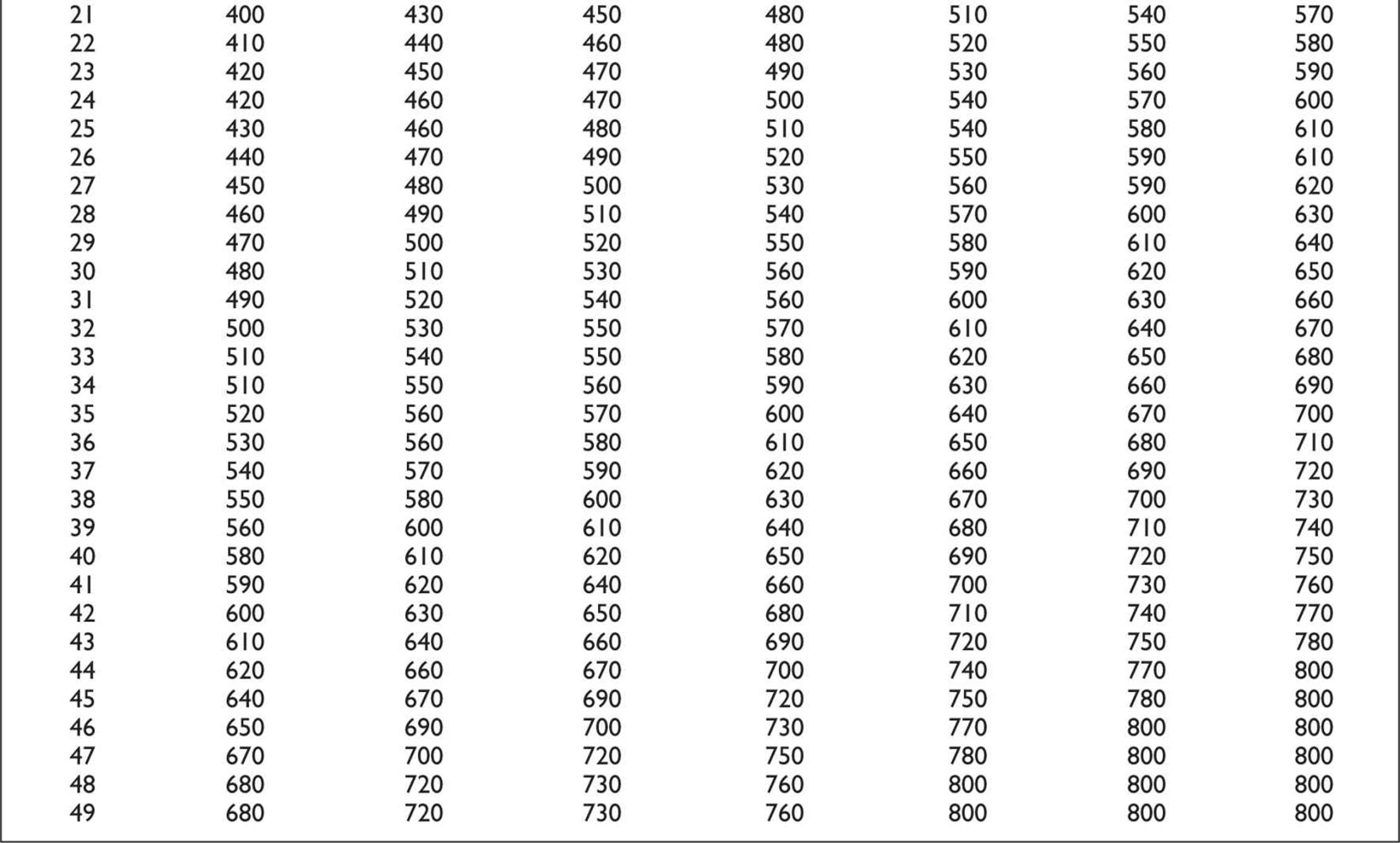
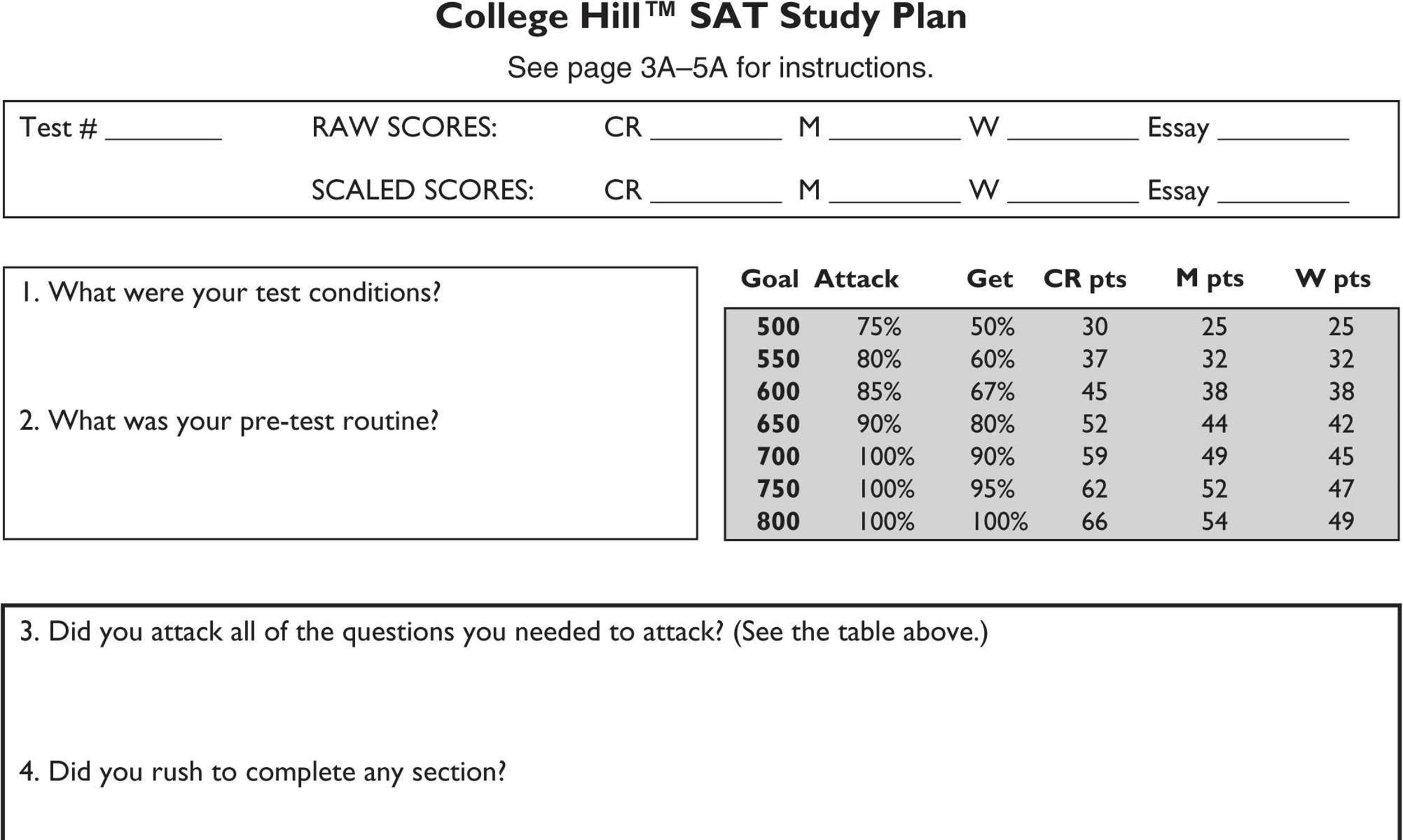
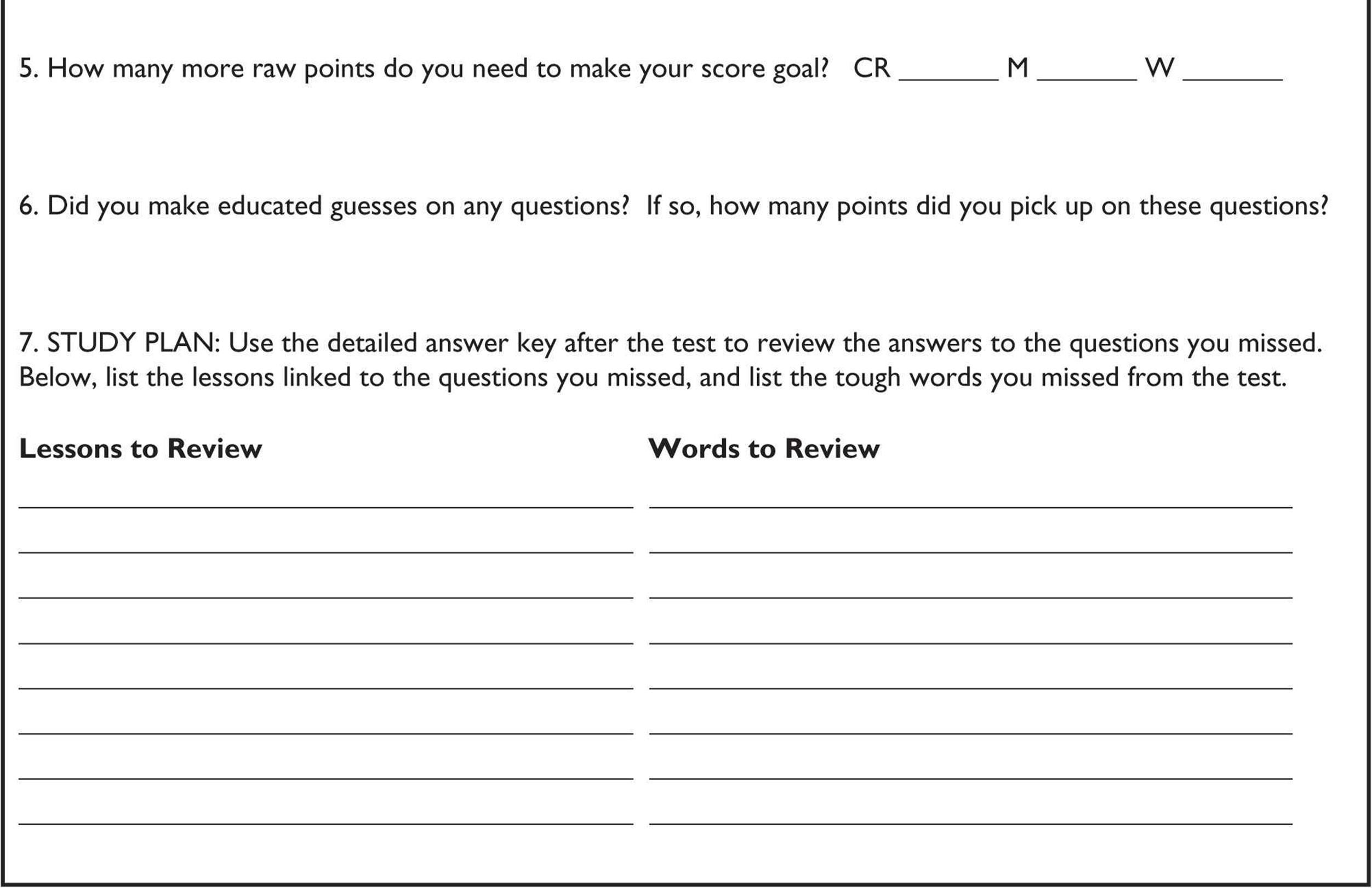
Detailed Answer Key
Section 1
Consider carefully the issue discussed in the following passage, then write an essay that answers the question posed in the assignment.
In a culture obsessed with superficial appearances, our leaders should be those who can see beyond the surface. Judging a book by its cover is the job of the plebeian or the consumer, but reading the book—pondering its contents and perhaps seeking to write new chapters—is the job of a leader.
Assignment: How important is it to look beyond superficial appearances? Write an essay in which you answer this question and discuss your point of view on this issue. Support your position logically with examples from literature, the arts, history, politics, science and technology, current events, or your experience or observation.
The following essay received 6 points out of a possible 6, meaning that it demonstrates clear and consistent competence in that it
• develops an insightful point of view on the topic
• demonstrates exemplary critical thinking
• uses effective examples, reasons, and other evidence to support its thesis
• is consistently focused, coherent, and well organized
• demonstrates skillful and effective use of language and sentence structure
• is largely (but not necessarily completely) free of grammatical and usage errors
The creature that Victor Frankenstein created was horrible to all who saw it, including Victor himself. Huge, misshapen and awkward, the creature was not even considered human. Indeed, the creature began to fulfill the only role that humans allowed him to occupy: the role of a bloodthirsty monster. Yet what Mary Shelley”s Frankenstein shows us is not so much how rare and horrible it is to alter the natural order, but how tragically simple it is to create a monster. Victor Frankenstein created a monster not by contravening nature, as many would believe, but by judging the creature by his outward appearance and treating him like an unworthy freak.
How simple it is to hate others, to consider them less than human, based on superficial analysis. Hatred is the desperate accomplice of fear. In recent years, too many of us Americans—denizens of the land of the free and home of the brave—have become imprisoned by our hatred and cowed by our fear of the unknown. Our leaders are too often complicit in rousing this fear and fueling this hate, and in mistaking a quick trigger finger for bravery in the face of threat. They become quick to imprison or kill people who scare us at first, rather than acknowledge that they are humans with rights. They see the populace cringing at foreigners because foreigners attacked us in 2001. They can”t see past their irrational fear to the enormous need to reach out to disenfranchised and subjugated cultures and listen to their concerns. If only Victor Frankenstein had tried to learn what his creature would need once it was given life.
Our leaders are often the blindest of all because, to survive, they must not edify but pander. They see the populace cringing in fear at the prospect of human cloning because they imagine Frankenstein”s monster. They can”t see past their irrational fear to the huge potential medical benefits of stem cell research. They refuse to see that clones are indistinguishable from twins, and that twins are not horrible monstrosities. We can”t really expect politicians or the media—who pander to popularity polls and big corporate donations—to see the world for what it truly is. They judge the world book by its cover, as did the angry villagers of Ingolstadt.
Our current situation will get better only once a critical mass of the American population begins to see that we are creating monsters everywhere by our irrational fear of the new and the foreign. We value instant polls of superficial and uninformed opinions more than careful thought and deep analysis. Perhaps it”s time to open the book and read it carefully rather than just glancing at the cover.
The following essay received 4 points out of a possible 6, meaning that it demonstrates adequate competence in that it
• develops a point of view on the topic
• demonstrates some critical thinking, but perhaps not consistently
• uses some examples, reasons, and other evidence to support its thesis, but perhaps not adequately
• shows a general organization and focus, but shows occasional lapses in this regard
• demonstrates adequate but occasionally inconsistent facility with language
• contains occasional errors in grammar, usage, and mechanics
Whoever said you can”t judge a book by its cover probably never had to drive on the highway behind a Hummer. Americans are obsessed with making a first impression, usually an impression of aggression and wealth. Certainly, first impressions about human beings are usually wrong, but American culture is, unfortunately, being increasingly defined by consumer items that give an aggressive first impression and last impression. These items, unlike human beings, are designed carefully, and their first impressions are intended to convey the entire product.
A good example of this is the Super Bowl. It has become a flashy, decadent display of consumption rather than what it should be, a display of athletic prowess. Our obsession with consumer goods that make us seem more attractive or stronger and more powerful have made it clear that we”re not concerned with substance as much as appearances. Every commercial shouts at you that first appearances are everything. Our schools are filled with people who think that the most important things in their lives are what shoes they wear or what cell phone they use.
Popular psychologists like Dr. Phil appear on television and tell us how important it is for us to be ourselves and not let other people tell us who we are, and then a string of commercials comes on telling you how a beer or car or deodorant makes you look more attractive. Which message do we really hear?
The following essay received 2 points out of a possible 6, meaning that it demonstrates some incompetence in that it
• has a seriously limited point of view
• demonstrates weak critical thinking
• uses inappropriate or insufficient examples, reasons, and other evidence to support its thesis
• is poorly focused and organized and has serious problems with coherence
• demonstrates frequent problems with language and sentence structure
• contains errors in grammar and usage that seriously obscure the author”s meaning
I think that definitely you can”t judge a book by its cover. Like my friend Cal is a really good wrestler and he even got into the state finals for his weight class. Everybody thinks he”s a total jock but not a lot of people know also that he works really hard every day after practice at his uncle”s garage and a lot of people think he”s as good as a lot of other mechanics. He”s a lot smarter than people give him credit for and he get”s really good grades in math.
As a matter of fact he”s in the honors level of math and will probably take calculus next year, so he”s not just a jock or even just a great mechanic. When you look at him, especially when he”s got his game face on just before a match, you would hardly believe that he could be a good student.
The next time you see an athlete, don”t assume that he is just a dumb jock. Professional athletes have sometimes become senators and business leaders, so sometimes they have minds as well as muscles.
Section 2

(Chapter 8, Lesson 1: Solving Equations)
2. E If the average of three numbers is 50, then their sum must be ![]() . If two of the numbers are 35 and 50, then the third is
. If two of the numbers are 35 and 50, then the third is ![]()
(Chapter 9, Lesson 2: Mean/Median/Mode Problems)
3. D Since the ones column has only one A, it is easy to figure out its value from there. The only value for A that yields a 7 in the ones column is 4.
(Chapter 9, Lesson 3: Numerical Reasoning Problems)
4. E The problem is best solved with a proportion: 
(Chapter 7, Lesson 4: Ratios and Proportions)

(Chapter 8, Lesson 3: Working with Exponents)
6. A Since there were 59 yes votes, 26 of which were from men, ![]() of them were from women. Since there were 76 women in total, 33 of whom voted yes,
of them were from women. Since there were 76 women in total, 33 of whom voted yes, ![]() of them must have voted no.
of them must have voted no.
(Chapter 11, Lesson 5: Data Analysis)
7. D They both start with x cards. After Mike gives Kenny 12 cards, Mike has ![]() and Kenny has
and Kenny has ![]() cards. If Kenny has twice as many as Mike, then
cards. If Kenny has twice as many as Mike, then

Since they each had 36 cards to start, they had a total of ![]() .
.
(Chapter 8, Lesson 7: Word Problems)
8. C The fraction that is walnuts equals the amount of walnuts divided by the 
(Chapter 7, Lesson 4: Ratios and Proportions)
9. B You might simplify this problem by plugging in possible values for the angle measures, remembering the parallel lines theorem. Your diagram might look like this:
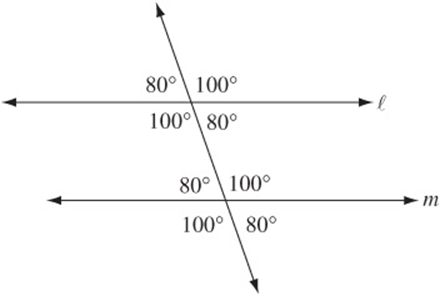
This example shows that ![]() , and the only other sum among the choices that equals 360° is (B).
, and the only other sum among the choices that equals 360° is (B).
(Chapter 10, Lesson 1: Lines and Angles)
10. A Either plug in the ordered pairs to check, or draw a graph, as long as you can do it quickly. Notice that the point (7, –1) satisfies both inequalities: ![]() and
and ![]() .
.
(Chapter 8, Lesson 6: Inequalities, Absolute Value, and Plugging In)
11. A If n has a remainder of 6 when it is divided by 12, it must be 6 more than a multiple of 12. Pick any one you like: 18, for example. When 18 is divided by 6, the remainder is 0.
(Chapter 7, Lesson 7: Divisibility)
12. B Any five-sided polygon can be divided into three triangles like so:
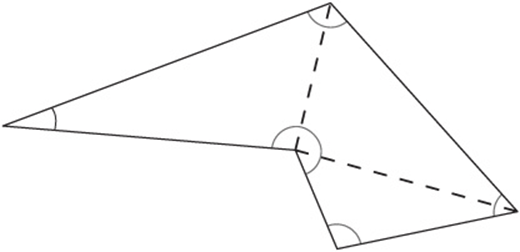
Since the sum of the angles in a triangle is 180°, the sum of the angles in this figure is ![]() . The average measure of the five angles, then, is
. The average measure of the five angles, then, is ![]() .
.
(Chapter 10, Lesson 2: Triangles)
13. D Remember that the word “is” can be interpreted as the equals sign (=). Therefore, “The number of dogs is 3 fewer than 4 times the number of cats” can be translated into![]() .
.
(Chapter 8, Lesson 7: Word Problems)
14. B Mark up the diagram with the information given:
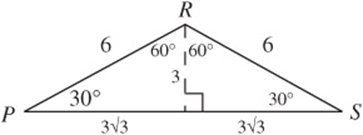
To find the area of the triangle, you need to use the formula area = base × height/2. Since the height divides the triangle into two 30° –60° –90° triangles, the other sides have lengths shown. The base of the triangle is ![]() and the height is 3, so the area is
and the height is 3, so the area is 
(Chapter 10, Lesson 3: The Pythagorean Theorem)
15. D The sum of the parts is ![]() .
.
Therefore, the parts are ![]() ,
, ![]() ,
, ![]() , and
, and ![]() of the whole. The largest share, then, is
of the whole. The largest share, then, is ![]() .
.
(Chapter 7, Lesson 4: Ratios and Proportions)
16. C Use the definition to translate the equation:
![]()
Now think about what values of m and n will work. Notice that 3 and 1 will work, but so will –3 and –1. Now plug these into the statements, and see if any are false. Since –3 is not greater than –1, statement I can be eliminated, and so can answers (B), (D), and (E). Notice that this means you don”t have to check statement II, because it”s in both remaining answers. Statement III must be true because if  , then
, then ![]() must equal 3 or –3. Therefore,
must equal 3 or –3. Therefore, ![]() equals 1 or –1, so it is an integer.
equals 1 or –1, so it is an integer.
(Chapter 6, Lesson 7: Thinking Logically and Checking)
(Chapter 9, Lesson 1: New Symbol or Term Problems)
17. C Let”s say there are x blue marbles in the jar. This means there are 3x white marbles, and ![]() red marbles, for a total of 10x marbles. Since 3x are white, the probability of picking a white is
red marbles, for a total of 10x marbles. Since 3x are white, the probability of picking a white is ![]() .
.
(Chapter 9, Lesson 6: Probability Problems)
18. D Think about how many options you have to fill each place, from left to right. Since the first person must be a girl, you have 6 options. Since the next must be a boy, you have 5 options. Since the next must be a boy, you have 4 options (one is already up there). Since the next must be a girl, you have 5 options left. This means that the total number of possible arrangements is ![]() .
.
(Chapter 9, Lesson 5: Counting Problems)
19. D If the two lines are parallel, then they have the 
Therefore, the rectangle has a width of 16 and a height of 12, so its area is ![]() .
.
(Chapter 10, Lesson 4: Coordinate Geometry)
20. E If v is the volume of the solid, then ![]() . Solving this equation for a gives
. Solving this equation for a gives ![]() so statement II must be true. Now go to the answer choices, and notice that you can eliminate any choice without II, namely (A) and (C). Also notice from the original equation that v could not be odd if any of the integers a, b, or c were even, therefore they must all be odd. This implies that
so statement II must be true. Now go to the answer choices, and notice that you can eliminate any choice without II, namely (A) and (C). Also notice from the original equation that v could not be odd if any of the integers a, b, or c were even, therefore they must all be odd. This implies that ![]() is odd, so statement I must be true. This eliminates choice (D). To check statement III, you need an expression for the surface area of the solid, which is
is odd, so statement I must be true. This eliminates choice (D). To check statement III, you need an expression for the surface area of the solid, which is ![]() . Since this is a multiple of 2, it is even, so statement III is also true.
. Since this is a multiple of 2, it is even, so statement III is also true.
(Chapter 9, Lesson 3: Numerical Reasoning Problems)
(Chapter 10, Lesson 7: Volumes and 3-D Geometry)
Section 3
1. A The fact that they rarely agreed implies that their opinions would often differ.
diverge = differ or move apart; coincide = fit together or occur simultaneously; retreat = move away; assemble = put together; truncate = cut short
2. D The sentence implies a contrast between what once was and what is now. If it is no longer an incontrovertible (irrefutable) truth, it must now be in doubt. enacted = put into effect officially; irrefutable = impossible to disprove; universal = true at all places and times; dubious = doubtful; conclusive = acting as final proof
3. C One who has encountered such tragedy would be expected to look to his painting as a departure from such abject (wretched) sorrow.
prudence = conservative wisdom; remorse = regret; adulation = admiration; solace = peaceful respite; melancholy = sadness; elation = extreme happiness
4. B Proponents of a new curriculum are people who support the change, while conservative educators are those who want to keep things the same.
repugnant = disgusting; innocuous = harmless; deplorable = regrettable; reprehensible = worthy of scorn; benevolent = kind; malicious = evil; auspicious = favorable
5. D What effect should a lack of oxygen have on climbers? It should be expected to weaken them. But this implies that the expedition leader”s plan to acclimate them (get them used to the environment) was a failure.
illusory = like an illusion; initiated = started; mitigated = soothed or made better; enervated = weakened; venerable = worthy of honor; absolved = forgiven
6. E One who questions norms (conventions) and mores (moral standards) is a rebel of sorts.
charlatan = a fake; surrogate = one who stands in place of another; philanthropist = one who gives to charity; pragmatist = one concerned with practical matters; iconoclast = one who destroys sacred objects or traditions
7. A If he stands in the negative camp, then he must have a firm opinion about the issue.
ambivalent = having conflicting opinions on an issue; unequivocally = without doubt; apathetic = lacking concern; furtively = secretively; impartial = fair and unbiased; adamant = stubborn; vehemently = passionately; subjective = being a matter of opinion
8. C If he was dismissed by his contemporaries, they must have thought negatively of him. The although implies a contrast, so modern thinkers must now think positively of him.
pedant = a know-it-all; derivative = deriving from the work of others; neophyte = beginner; vociferous = loudly opinionated; radical = one with an extreme opinion; visionary = able to envision the future; partisan = marked by party loyalty; conciliatory = bringing people together; hermit = one who prefers to live alone
9. C Passage 1 focuses on the study of molecules of which living organisms are composed. Passage 2 discusses the ways in which organisms harvest energy through chemical processes like photosynthesis and chemosynthesis, which are biochemical processes.
10. C The main point of the paragraph is in the first sentence: the study of life on Earth ultimately involves the study of molecules. The questions that follow are therefore questions about molecules that concern those who study life on Earth, that is, biologists.
11. A Passage 2 focuses on organisms that harvest energy in a way that is analogous to, but different from, photosynthesis. The process of converting energy into food for the organism, then, is a relevant topic for Passage 2.
12. D Passage 2 discusses how other organisms utilize the bacteria that harvest energy from sulfides, either by consuming them or incorporating them into their tissues. This concept is not discussed in Passage 1. Both passages discuss the conversion of light energy to food energy, and bonds within molecules. Only Passage 1 discusses the structure of cells and disease, specifically cancer.
13. C The author indicates that one should react with proper skepticism to those reports, thereby implying that they are probably untrue.
14. B The author asks (in line 21) the reader to compare the probability of being a victim of terrorism to the list of probabilities that follow, which are much greater, thereby implying that terrorism is not much of a threat.
15. E The personal recollection begins on line 60: I once had a conversation free-thinking The verifiable statistics abound in paragraphs 1, 2, and 3. The authoritative study is mentioned in lines 54–60. Common misconceptions are mentioned multiple times, as in lines 12–13: being killed by terrorists might seem to be a major risk.
16. B The author says that this penetrating insight is really a non sequitur, that is, something that doesn”t follow logically. Therefore it is not a penetrating insight at all.
17. A The author says that a feeling for what quantities or time spans are appropriate in various contexts is essential to getting the joke (lines 47–49), thereby implying that the couple, like those who slip between millions and billions, lack an appreciation for particular quantities.
18. C In the span of approximately 20 minutes the doctor said three different things about the procedure, so he contradicted himself frequently.
19. B The passage refines the usage of the word by saying the same organization, the same physical laws, thereby suggesting that the author meant rules of physics when he said organization.
20. C In lines 16–19, the author describes the realization that the phenomena we see result from the complexity of the inner workings between atoms as being dramatic and wonderful.
21. B In lines 20–22, the author says that his feeling of awe could be communicated through a drawing to someone who had also had this emotion, thereby suggesting that appreciating such art depends on having a similar experience as the artist.
22. D The author says that Jerry is a very good teacher in that everything that I thought was a mistake, he used to teach me something in a positive way. He never said it was wrong; he never put me down. We can infer, then, that Jerry would have done something positive and affirming.
23. A The parenthetical comment that precedes this sentence indicates that the fact that the line did not touch the flower pot was unintentional.
24. E The main point of the passage is that the author wanted to learn to draw to convey the awe he felt about the workings of nature and the physical world. So when he finishes by saying I was never satisfied, we know that he was never able to convey adequately his feelings about the beauty of the world.
Section 4
1. B The pronoun which is out of place because it is assumed to refer to the preceding noun poets. If the pronoun is eliminated, the meaning is clearer and the two clauses are parallel.
(Chapter 15, Lesson 5 and Lesson 15)
2. E This is an awkward usage of the gerund preparing. To convey purpose, the infinitive to prepare is much more effective.
(Chapter 15, Lesson 3)
3. D This contains a dangling modifier. The modifying phrase that begins the sentence describes Carla rather than Carla”s anxiety.
(Chapter 15, Lesson 7 and Lesson 8)
4. C This is a sentence fragment without a verb. Choice (C) completes the thought and makes a complete sentence.
5. C The participle swimming dangles in this sentence. Justine should follow the participial phrase because she is the one swimming, not the current.
(Chapter 15, Lesson 7)
6. D The comparison is not parallel. The sentence should say that writing one thing is more difficult than writing something else. (Chapter 15, Lesson 3)
7. A This sentence is correct.
8. D This is a run-on sentence, or a comma splice. Two sentences cannot be “spliced” together with only a comma; you must use a conjunction, a semicolon, or a colon. Since the second clause explains the idea in the first clause, a colon is most appropriate.
(Chapter 15, Lesson 15)
9. B The two clauses are not properly coordinated. Since the second clearly contradicts the first, a contrasting conjunction like but or a contrasting coordinating adverb like nevertheless should be used.
(Chapter 15, Lesson 15)
10. E The verb reveals does not agree with the subject theories and should be reveal instead.
(Chapter 15, Lesson 1 and Lesson 2)
11. D The pronoun their does not agree in number with its antecedent board and should be changed to its.
(Chapter 15, Lesson 5)
12. B The phrase his staff and him serves as the subject of the verb had diverted, and so it must be in the subjective case: his staff and he.
(Chapter 15, Lesson 6)
13. C This is incorrect past participle form; the present perfect form of to run is have run.
(Chapter 15, Lesson 9 and Lesson 13)
14. B The subject of the verb were is taunting. (This is an inverted sentence because the subject comes after the verb.) Since taunting is singular, the verb should be was.
(Chapter 15, Lesson 1)
15. E The sentence is correct.
16. C The verb produce does not agree with its subject refraction. It should be changed to produces.
(Chapter 15, Lesson 1)
17. D The phrase receptive for is not idiomatic. The standard idiom is receptive to.
(Chapter 15, Lesson 10)
18. C This word answers the question how did she react? Therefore it modifies a verb and should be in the form of an adverb: emotionally.
(Chapter 15, Lesson 12)
19. B This phrase is part of a parallel construction: “not A but B.” The construction is parallel only if this phrase is eliminated.
(Chapter 15, Lesson 3)
20. B This phrase is redundant. The word while means at the same time, so the second phrase should be eliminated.
(Chapter 15, Lesson 12)
21. B The verb have expressed does not agree with its subject coalition, and should be changed to has expressed.
(Chapter 15, Lesson 1 and Lesson 2)
22. D This is an illogical comparison. A way cannot be compared to a hard drive. The phrase should be the way a computer hard drive stores information.
(Chapter 15, Lesson 4)
23. D The pronoun their does not agree with its antecedent museum, and should be changed to its.
(Chapter 15, Lesson 5)
24. B This is an idiom error. The correct form of this comparison is “prefer A to B” not “prefer A more than B.”
(Chapter 15, Lesson 3 and Lesson 10)
25. D Since only two films are being compared, the comparative adjective more is required.
(Chapter 15, Lesson 4: Comparison Problems)
26. B The phrase Emma and I is the object of the verb included and therefore should take the objective case Emma and me.
(Chapter 15, Lesson 6: Pronoun Case)
27. B The past perfect tense requires the past participle swum.
(Chapter 15, Lesson 9: Tricky Tenses)
28. E The sentence is correct as written.
29. A The participle building dangles in the original sentence. It should be changed to the infinitive to build so that it properly modifies the verb try.(Chapter 15, Lesson 7: Dangling and Misplaced Participles)
30. B The modifying phrases are awkwardly placed. Modifiers should obey the law of proximity and be as close as possible to the words they modify.
(Chapter 15, Lesson 8)
31. A The modifying phrase at the beginning is dangling. Since she is a doctor, she should follow the opening phrase. (D) and (E) do not work because they improperly imply that she was bothered by the children rather than their treatment. You might notice that the correct choice contains verbs in the passive voice. Although you should minimize the use of the passive voice, it is not always incorrect.
(Chapter 12, Lesson 10: Write Forcefully)
(Chapter 15, Lesson 7 and Lesson 8)
32. E This paragraph discusses Montessori”s methods and results in the Casa dei Bambini, and so the trivial and unrelated fact that there were fifty students in her first class is out of place.
33. A The pronoun it refers to Montessori”s day care center, and so this sentence should follow the one that mentions the day care center, but precede the sentence that discusses her theories in detail.
34. D Revision (D) is the most concise and effective of the choices.
35. C Sentences 8 and 9 discuss Montessori”s philosophy and its effectiveness. Sentence 8 indicates that Montessori decided it was important to help each child through his or her own curriculum, which is clearly a focus on the individual child.
Section 5
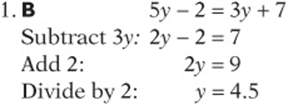
(Chapter 8, Lesson 1: Solving Equations)
2. D Since vertical angles are equal, ![]() . Since angles that form a straight line have a sum of 180°,
. Since angles that form a straight line have a sum of 180°, ![]() . Therefore
. Therefore ![]() . So
. So ![]() .
.
(Chapter 10, Lesson 1: Lines and Angles)

(Chapter 7, Lesson 3: Fractions)
4. C Since the prime factorization of 98 is ![]() , and since the greatest common factor of m and 98 is a prime number, that greatest common factor must be 2 or 7. Since it is not even, it must be 7.
, and since the greatest common factor of m and 98 is a prime number, that greatest common factor must be 2 or 7. Since it is not even, it must be 7.
(Chapter 7, Lesson 7: Divisibility)
(Chapter 8, Lesson 5: Factoring)
(Chapter 9, Lesson 1: New Symbol or Term Problems)

The smallest possible integer value for k is –9 and the greatest is 10. The total number of integers between 9 and 10, inclusive, is ![]() .
.
(Chapter 6, Lesson 2: Analyzing Problems)
(Chapter 8, Lesson 6: Inequalities, Absolute Value, and Plugging In)
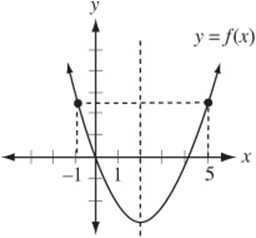
6. A Since f is a quadratic function, its graph is a parabola with a vertical axis of symmetry through its vertex, which in this case is the line ![]() . This means that, for any given point on the graph, its reflection over x = 2 is also on the graph. Notice from the given graph that the value of f(5) is about 2.5, as shown above. If we reflect this point, (5, 2.5) over the axis of symmetry, we get the point (–1, 2.5). In other words,
. This means that, for any given point on the graph, its reflection over x = 2 is also on the graph. Notice from the given graph that the value of f(5) is about 2.5, as shown above. If we reflect this point, (5, 2.5) over the axis of symmetry, we get the point (–1, 2.5). In other words,![]() , so
, so ![]() .
.
7. C It helps to know the perfect squares and the perfect cubes. The first seven perfect squares greater than 1 are 4, 9, 16, 25, 36, 49, and 64. The first three perfect cubes are 8, 27, and 64. Clearly, the only integer between 1 and 100 that is both a perfect cube and a perfect square is ![]() . Therefore
. Therefore ![]() and
and ![]() , so
, so ![]() .
.
(Chapter 8, Lesson 4: Working with Roots)
8. B This is a rate problem, so remember the basic rate formula: distance = rate × time. Start by picking a value for the distance from Amanda”s home to work. No matter what distance you choose, the final answer will be the same, so choose a distance that”s easy to calculate with, like 50 miles. If it takes her 60 minutes (1 hour) to get to work, she must be going 50 miles/hour. If she increases her speed by 20% for the trip home, then her speed coming home is (1.20) (50 miles/hour) = 60 miles/hour. To travel 50 miles at 60 miles/hour will take her (50 miles)/(60 mph) = 5/6 hour, which is 5/6(60 minutes) = 50 minutes.
(Chapter 9, Lesson 4: Rate Problems)
9. 0.4 Remember that “percent” means “divided by 100,” so 0.5 percent of 80 means 0.5 ÷ 100 × 80 0.4
(Chapter 7, Lesson 5: Percents)
10. .333 or 1/3 Just pick three consecutive odd integers, like 1, 3, and 5. Since d is the middle of these, ![]() . Since s is the sum of these,
. Since s is the sum of these, ![]() . So d divided by s is 3/9 or 1/3.
. So d divided by s is 3/9 or 1/3.
(Chapter 9, Lesson 3: Numerical Reasoning Problems)
11. 30 4/9 of c2 is 24

(Chapter 6, Lesson 4: Simplifying Problems)
(Chapter 8, Lesson 1: Solving Equations)
12. 60 The sum of the four angles in a quadrilateral is 360 °. The sum of the parts in the ratio is ![]() . Therefore the angles are 3/18, 4/18, 5/18, and 6/18 of the whole, which is 360°. So the smallest angle measures
. Therefore the angles are 3/18, 4/18, 5/18, and 6/18 of the whole, which is 360°. So the smallest angle measures ![]() .
.
(Chapter 10, Lesson 2: Triangles)
(Chapter 7, Lesson 4: Ratios and Proportions)

(Chapter 6, Lesson 4: Simplifying Problems)
(Chapter 8, Lesson 2: Systems)
14. 6 Simply substituting ![]() in the equation gives
in the equation gives  The quickest way to simplify this expression is to multiply both the numerator and the denominator by the common denominator, 8. This gives
The quickest way to simplify this expression is to multiply both the numerator and the denominator by the common denominator, 8. This gives ![]() . If you happen to be an algebra jock, you might notice that you can simplify the original expression by multiplying numerator and denominator by the common denominator
. If you happen to be an algebra jock, you might notice that you can simplify the original expression by multiplying numerator and denominator by the common denominator ![]() , which is equivalent to
, which is equivalent to ![]() . This simplifies the complex expression to just 2m, which equals 6 when m = 3.
. This simplifies the complex expression to just 2m, which equals 6 when m = 3.
15. 81 By guessing and checking positive integers, you should be able to see that the only positive integers that satisfy the equation are 5 and 4. Therefore ![]() .
.
(Chapter 9, Lesson 3: Numerical Reasoning Problems)
16. 10 Five out of the 15 marbles are white. If x more white marbles are added, the probability of choosing a white marble is  This fraction must be at
This fraction must be at

(Chapter 9, Lesson 6: Probability Problems)
NUMBER OF BOOKS READ DURING SUMMER VACATION
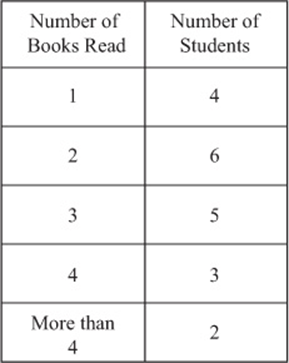
17. 2.5 Notice that the question asks for the median of these numbers, not for their average or mode. The median is the “middle” number when the numbers are listed in order, or the average of the two middle numbers if there are an even number of numbers. According to the table, there are 20 numbers representing the number of books each child has read:
1, 1, 1, 1, 2, 2, 2, 2, 2, 2, 3, 3, 3, 3, 3, 4, 4, 4, 5+, 5+
We don”t know the final two numbers in the list, only that they are integers greater than 4. That”s okay: to find the median, we don”t need these last two numbers; we only need to find the average of the two middle numbers (the 10th and 11th), which are 2 and 3. Therefore the median is 2.5.
18. 4 If she took a shots in her first game and made 50% of them, then she made .5a shots in the first game. Similarly, she made .6b shots in the second game. If she made 52% of her shots altogether, then
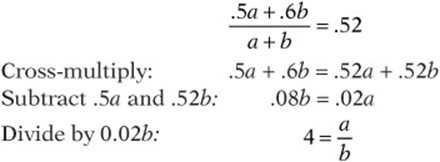
(Chapter 7, Lesson 4: Ratios and Proportions)
(Chapter 7, Lesson 5: Percents)
Section 6
1. B Sandra”s father”s words were not thoughtful or useful, but rather they were hollow clichés. They were overused and thoughtless.
irate = angry; inane = pointless; homogeneous = the same throughout; flamboyant = lively; altruistic = selfless
2. C If he was courageous in prison, he must not have given up his fight.
treacherous = deceitful; futile = having no hope of success; fortitude = strength; premeditated = planned in advance; porous = full of holes
3. A Since the teachers couldn”t hear themselves talk, the construction must have been noisy, and therefore was not very constructive to learning (no pun intended).
din = noise; conducive = helpful, constructive; averse = opposed to; discernible = detectable; irascible = easily angered
4. C The sentence implies that solutions to physics problems are approximate, so they cannot be exact. The approximate solution would be sufficient as long as the complicating factors are small.
negligible = not significant; plausibly = with a good likelihood of success; ethically = with regard to moral standards
5. D Martial resources are those resources that sustain an army”s ability to fight; they are the means to continue fighting. If the factions both have access to these resources, the fight is likely to drag on.
mediation = attempt to resolve a conflict
6. C Since Jung was modest in his therapeutic claims (lines 4–5) and cautious (line 11) when consulted by schizophrenics, we can conclude that he did not yet believe that his therapy worked for all mentally ill patients.
7. A The sentence indicates that psychoanalysis could bring about a psychotic episode.
8. C The passage says that the comic … seems bound to its time, society, cultural anthropology (lines 7–8). This implies that it”s harder to find something humorous if it is from another culture or time. Choice (C) is the most foreign to modern Americans.
9. C Because the passage says that it is harder to understand the comedy of other societies and eras because of cultural obstacles, the effort is in overcoming these obstacles.
10. B The author states that the host”s introduction dropped like a stone in our midst (lines 9–10), and that no response at all to this introduction was the proper response (line 12). The rest of the essay makes clear that the author considers the host”s comments, particularly with its focus onliterature, to be inappropriate.
11. C The author defines the term somewhat in lines 55–57 by listing the forms to which the term literary is applied: novels and short stories and poems. Throughout the passage, the author distinguishes literary works from works of nonfiction, which can be very well written.
12. B The interviewer asked the writers about the “literary experience” (line 20) of the day, and then whether they “write anything literary” (lines 36–37), when in fact they did not write literature at all, but rather nonfiction.
13. C Those writers are mentioned as our models by the author, suggesting that the author and the other writers have been influenced by them.
14. B In saying that writers were admired for their ability to harness the issues, the author is saying that they make them easy to understand for their readers.
15. E The writers being interviewed had said that they felt they were already doing satisfactory work (lines 37–38). The callers implied that they felt the same way.
16. C The phrase the great preponderance of what writers now write and sell refers to the majority of what they write and sell.
17. B The first sentence indicates the purpose of this passage: To understand … Aristotle … it is necessary to apprehend his imaginative background (lines 1–3), in other words, to understand the preconceptions behind his theories.
18. E This paragraph discusses the ancient Greek idea that mechanical devices are somehow imbued with the spirit of animals with similar abilities, for instance, an airplane having the spirit of a bird. The comment that animals have lost their importance in our imaginative pictures of the world indicates that modern thinkers no longer suppose any link between the lifespirit of animals and the behavior of machines.
19. C The imaginative preconceptions of Aristotle are explained in the second and third paragraphs, where it says that to the Greek, it seemed more natural to assimilate apparently lifeless motions to those of animals (lines 47–49).
20. A The passage says that the … mechanical view hardly suggested itself, except in the case of a few men of genius (lines 36–38). So these men of genius had the mechanical view.
21. E The passage says that to the modern man of science, the body of an animal is a very elaborate machine (lines 42–43). The difference between animals and machines is diminished with discoveries about the physico-chemical structure (lines 44–45) of animals, or the mechanical and chemical nature of biology.
22. A In saying that, to the ancient Greek, it seemed more natural to assimilate apparently lifeless motions to those of animals (lines 47–49), the author is saying that Greeks were inclined to compare the motions of lifeless things to the motions of living things, and that these comparisons were the basis of a general theory of physics (lines 53–54).
23. C The passage says that Every Greek philosopher … had been taught in childhood to regard the sun and moon as gods (lines 58–61), and then that Anaxagoras was prosecuted for impiety because he thought that they were not alive (lines 61–63). This implies that he departed dramatically from his childhood teachings.
24. B The Hellenic love of order and geometric simplicity (line 67) is attributed to the Divine Being who moves the heavenly bodies. These heavenly bodies were said to move with regularity (line 56) and superior perfection (lines 57–58). Therefore, it can be inferred that this love of order and geometric simplicity pertains to the movement of the heavenly bodies.
Section 7
![]() of 60 is 40, and
of 60 is 40, and ![]() .
.
(Chapter 7, Lesson 3: Fractions)

(Chapter 6, Lesson 4: Simplifying Problems)
3. C This question is asking what the remainder is when 29, 21, and 64 are each divided by 3. When 29 is divided by 3 the remainder is 2; when 21 is divided by 3 the remainder is 0; and when 64 is divided by 3 the remainder is 1.
(Chapter 7, Lesson 7: Divisibility)

(Chapter 9, Lesson 1: New Symbol or Term Problems)
5. A In a triangle, any side must have a length that is less than the sum of the two other lengths but greater than the difference of the two other lengths. Therefore, the third side must have a length between 15 –9 = 6 and 15 + 9 = 24, so a length of 5 is impossible.
(Chapter 10, Lesson 2: Triangles)
6. B The volume of a cube is equal to s3, where s is the length of one edge. If ![]() , then
, then ![]() , and so each square face has an area of
, and so each square face has an area of ![]() . Since a cube has six faces, the total surface area is
. Since a cube has six faces, the total surface area is ![]() .
.
(Chapter 10, Lesson 7: Volumes and 3-D Geometry)

So the numbers are 2, 6, 10, and 14. The median is the average of the two middle numbers:  .
.
(Chapter 9, Lesson 2: Mean/Median/Mode Problems)
8. A Indicate the congruent sides with tick marks: in a triangle, the angles across from equal sides are equal; indicate this in the diagram. Your angles should be marked as shown. Since the angles in a triangle have a sum of 180°, ![]() ,
,

(Chapter 10, Lesson 2: Triangles)
9. D Notice that the graph is of all the points that are more than one unit away from –1. The distance from a point to –1 is |x –(–1)|, or, ![]() ; if this distance is greater than one, then
; if this distance is greater than one, then ![]() .
.
(Chapter 8, Lesson 6: Inequalities, Absolute Value, and Plugging In)
10. B “Must be true” kinds of questions are often best answered by process of elimination with examples.
Begin with a simple set of values, for instance ![]() ,
, ![]() , and
, and ![]() . Notice that these values satisfy all of the given information. This example clearly shows that statement I need not be true, because 0 is not greater than 0, and that statement III need not be true, because (0)(0) is not greater than (–1)2. This leaves only statement II as a possibility, so the answer must be (B).
. Notice that these values satisfy all of the given information. This example clearly shows that statement I need not be true, because 0 is not greater than 0, and that statement III need not be true, because (0)(0) is not greater than (–1)2. This leaves only statement II as a possibility, so the answer must be (B).
(Chapter 6, Lesson 7: Thinking Logically and Checking)
(Chapter 9, Lesson 3: Numerical Reasoning Problems)
11. E You have five choices for the first digit: 1, 3, 5, 7, and 9; ten choices for the middle digit (any digit will do), and five choices for the last digit: 0, 2, 4, 6, and 8. So the total number of possibilities is ![]() .
.
(Chapter 9, Lesson 5: Counting Problems)
12. B To find how many more seconds it will take the machine to cut circle A than circle B, you can find the length of time it takes to cut each circle and subtract them. The laser cuts the circumference of each circle, so you must find that first. Circle A has an area of 64π. Since the area of a circle is . r2, the radius of the circle is 8. Since the area of circle B is 16π, its radius is 4. The circumference of a circle is 22r, so the circumference of A is ![]() and the circumference of B is
and the circumference of B is ![]() . The difference of their radii is
. The difference of their radii is ![]() . The time it takes to cut that length is given by the formula time = distance/rate.
. The time it takes to cut that length is given by the formula time = distance/rate.

(Chapter 10, Lesson 8: Circles)
(Chapter 9, Lesson 4: Rate Problems)

Therefore the slope of CB is –6/7. Using the slope
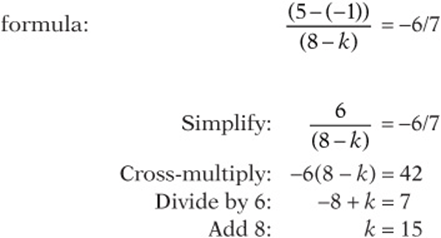
(Chapter 10, Lesson 4: Coordinate Geometry)
![]() You can factor even further in terms of primes:
You can factor even further in terms of primes: ![]() . This shows that there are a maximum of eight factors of 2, so the greatest power of 2 that is a factor of m is 28.
. This shows that there are a maximum of eight factors of 2, so the greatest power of 2 that is a factor of m is 28.
15. D First draw a diagram to see how the area of an equilateral triangle is related to the lengths of the sides:
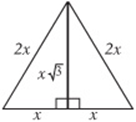
Notice that the height (which is also the bisector of the “top” angle) divides the triangle into two 30° 60°-90° triangles, with sides as shown. The area of a triangle is base × height/2, which in this case is
 Since the area is given as,
Since the area is given as, ![]() x must equal 6. Substituting this into the diagram, each smaller triangle has sides of length 6,
x must equal 6. Substituting this into the diagram, each smaller triangle has sides of length 6, ![]() and 12. Therefore the sum of the perimeters of the two triangles is
and 12. Therefore the sum of the perimeters of the two triangles is ![]()
(Chapter 10, Lesson 2: Triangles)
(Chapter 10, Lesson 3: The Pythagorean Theorem)
(Chapter 10, Lesson 5: Areas and Perimeters)
16. B At 4:00 pm, there are 1,000 bacteria. Since the population doubles every two hours, there must have been half as many two hours ago. So at 2:00 pm there were 500 bacteria, and at 12:00 noon there were 250 bacteria. (Notice that the fact that there were 100 bacteria to start is irrelevant.)
(Chapter 9, Lesson 4: Rate Problems)
Section 8
1. D If she was relieved, the tumor must not have been dangerous.
malignant = dangerous; irreverent = disrespectful; serene = calm; benign = harmless; mortal = capable of dying
2. C If the jargon rendered the speech decipherable only to a few audience members, then it rendered the speech undecipherable to the rest of the audience. Therefore the message was obscured.
3. D If one prefers style to performance, then the cosmetic appeal of the car would be most important.
utilitarian = concerned with practical uses; pragmatic = concerned with function; aesthetic = pertaining to beauty
4. A If something serves its purpose only temporarily, then it is by definition provisional.
provisional = serving a temporary purpose; polemical = relating to a controversial intellectual position; pedantic = acting like a know-it-all
5. E A foil is a character that provides a dramatic contrast to the personality of another character. The but in the sentence indicates that Ms. Linney is going against the tradition, and does not portray her character demurely (modestly).
bluster = brashness; forgo = abandon an inclination or plan; coyness = shyness; bombast = pompous speech; eschew = abandon; impudence = impertinence, rudeness
6. C Despite implies an ironic situation. If analysts have tried to depict the stock market as driven by predictable principles, it would be ironic if people believed that it was not predictable at all.
invaluable = very valuable; complacent = self-satisfied; capricious = arbitrary, whimsical; responsive = tending to respond quickly; obscure = not widely known
7. C The control is mentioned in the context of the creation of life (line 10). This is the process of conception.
8. B The author says that this “outsourcing” … leaves us with a profoundly hollow feeling (lines 14–18). This indicates a disdain.
9. E This statement is from those who turn [their] noses up at one who would offer us the most precious gift in the universe, that is, the advocates of cloning are turning up their noses at nature or God.
10. A The parenthetical comment suggests that the essential random … processes that form the basis of natural selection may be only seemingly random. This suggests that these processes may be planned rather than random.
11. D The “unnatural selection” is described as involving an assembly line (lines 29–31), which is a type of mechanical procedure, and carefully designed and tested features (line 32), which implies a selection of characteristics. The random processes (lines 27–28) are attributed to naturalselection.
12. A The passage implies that those who know a little bit about the history of technology (lines 55–56) would not have such irrational fears about human cloning (line 53). Therefore you can eliminate choice (D). The fact that these fears are called irrational eliminates choices (B) and (E). Since these fears are said to abound from all parts of the political spectrum (line 54), you can eliminate choice (C). The passage never mentions that the opponents are very religious, so the answer is (A).
13. C Surgery is mentioned in line 63 as something significant (line 57) that was once denounced (line 58).
14. C After quoting Mr. Rifkin, the author then goes on to describe the illogic behind the quote.
15. B The passage mentions that human twins “have their own unique thoughts” in order to refute the claim that identical genes put a human into a genetic straitjacket (lines 77–78).
16. A The passage says that familiarity [with procreational technologies] dissipates fear (line 128), implying that these technologies become more acceptable as they become more familiar.
17. A This paragraph says that ignorant superstition (line 136) stands in the way of technologies that can produce ample food for a starving world and cure devastating illnesses (lines 133–135). This indicates anger at an unjust situation.
18. C In each case, the questions represent the perspective that the author argues against.
19. B The first passage says that cloning technologies will make the world forever different from what it is today (lines 51–52), and the second says that these technologies can produce ample food for a starving world and cure devastating illnesses (lines 134–135).
Section 9
1. C The infinitive to move more effectively conveys purpose than does the phrase by moving. Also, the modifier more closely has the incorrect form. It should be in adjectival form closer, because it modifies the noun source.
(Chapter 15, Lesson 12: Other Modifier Problems)
2. E The original sentence illogically suggests that cell phones standardized their own technology. The only choice that logically coordinates the ideas is choice (E).
(Chapter 15, Lesson 15: Coordinating Ideas)
3. E The colon is misused in the original sentence, since it does not introduce a list of examples or an independent explanatory clause. Choice (B) has the same problem. Choices(C) and (D) use improper idioms. Only choice (E) conveys the idea clearly and idiomatically.
(Chapter 15, Lesson 15: Coordinating Ideas)
4. B The original phrasing is a sentence fragment; it contains no verb. Choices (B), (C), and (D) correct this mistake, but (C) and (D) do not clearly convey what protected the city. Only choice (B) conveys the idea logically.
(Chapter 12, Lesson 7: Write Logically)
5. A The original sentence is correct. The phrase preceding the comma is an appositive modifying On Writing Well. Therefore, (B) and (C) cause this modifier to be misplaced. Choice (D) is a fragment and (E) misplaces the modifier by William Zinsser.
6. E The original phrase shifts the pronoun from you to one. Choices (B) and (C) are illogical, and (D) is unidiomatic. Choice (E) is concise and avoids these problems.
7. A The original sentence conveys the idea clearly and effectively. Choices (B) and (C) misuse the singular pronoun it to refer to the plural noun pigeons. Choice (D) is awkward, and (E) produces a fragment.
8. D Choice (D) is the only choice that makes the comparison idiomatic, logical, and parallel.
(Chapter 15, Lesson 3: Parallelism)
9. C In the original sentence, the participle revealing is misplaced, since it does not modify the closest noun friends. Choice (B) repeats this error, and choices (D) and (E) are unidiomatic. The only choice that fixes this problem and conveys the logical sequence of ideas is choice (C).
(Chapter 15, Lesson 7: Dangling and Misplaced Participles)
10. B The participle inspired is left dangling in the original sentence. Its subject, Gerald, must follow the comma. Since choice (E) produces a sentence fragment, the best choice is (B).
(Chapter 15, Lesson 7: Dangling and Misplaced Participles)
11. B The original phrasing does not clearly convey who decided. Also, the noun club is singular, so the plural pronoun they is inappropriate. Choice (B) concisely and clearly fixes these problems.
(Chapter 15, Lesson 5: Pronoun-Antecedent Disagreement)
12. A The original phrasing is clear, logical, and effective.
13. C Since this sentence is giving general advice about a general practice, the gerund acknowledging is more effective than the infinitive to acknowledge. Further, the gerund is parallel with the gerund subverting with which it is compared.
(Chapter 15, Lesson 3: Parallelism)
14. E The sentence is not parallel. The first two items in the list establish the pattern: get … avoid free-thinking So the last item should be reduce ….
(Chapter 15, Lesson 3: Parallelism)
1A non sequitur is a statement that does not follow logically from previous statements.
1Schizophrenia is a type of mental illness characterized by a withdrawal from reality and, occasionally, by delusions and mood disorders.
1Excessive pride or arrogance
2A futuristic novel by Aldous Huxley that describes the mass production of genetically identical human babies